Travels with Dick and Karen
Paris: Part 1
The Neighborhood |
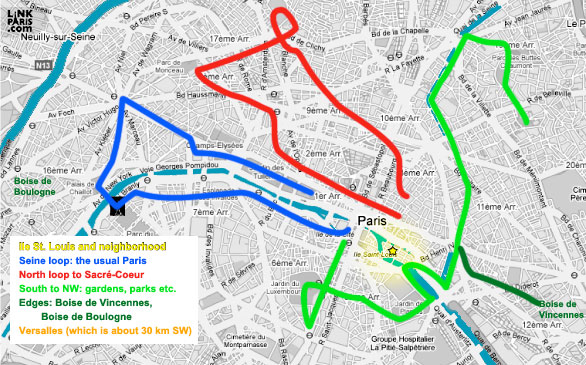
|
We flew the great circle route over Greenland. The sun didn't really set during the night.
|
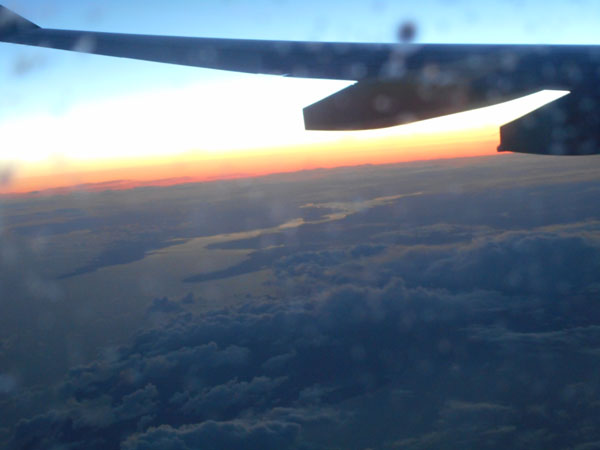 |
We landed in the rain. |
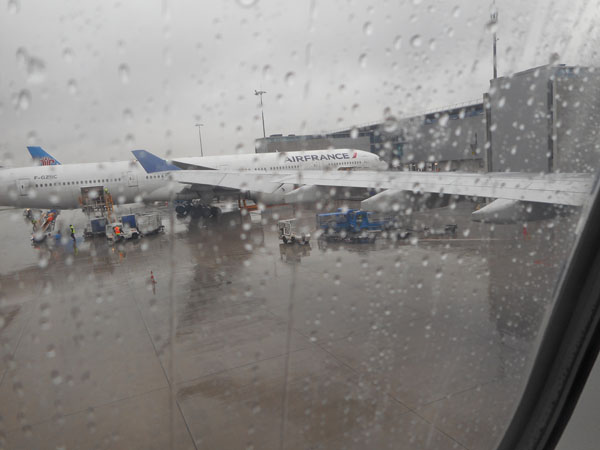 |
| By now it was well after 1 AM "body time". Given how long we had been awake and how convoluted the airport felt, we were very glad we had arranged a car to pick us up and deliver us to our apartment ... |
 |
on quiet Ile Saint Louis, one of the two main islands in the middle of the river Seine, right in the heart of Paris. Here's "our" street -- with the arrow pointing to our door.
|
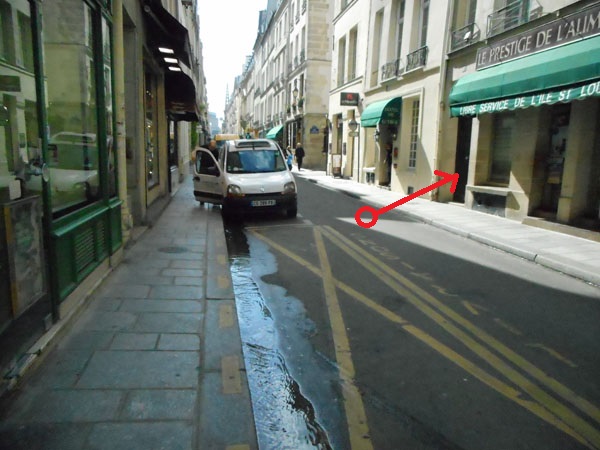 |
Inside we find the stairwell, with a very tiny elevator. We only used the elevator when dealing with the luggage. Our Apartment was up one floor in this centuries-old stone building. As is common in most of the world, the floor above the "ground" floor is given the number 1.
|
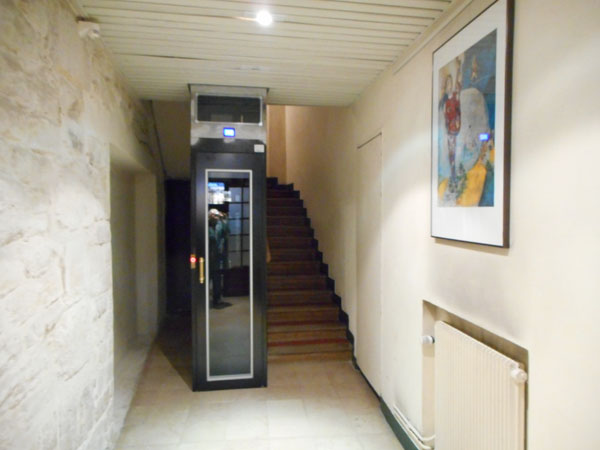 |
Our apartment faced, in fact occupied, the center courtyard formed by having four multi-story buildings back up to each other. The living room extended into the courtyard by means of this greenhouse-like structure.
There was a large-screen cable TV (which we didn't use) and high-speed wireless Internet (which we did).
It was very quiet ... except when it rained on the frosted glass "roof", which was musical ... or when Notre Dame, on the next island, was in full peal. |
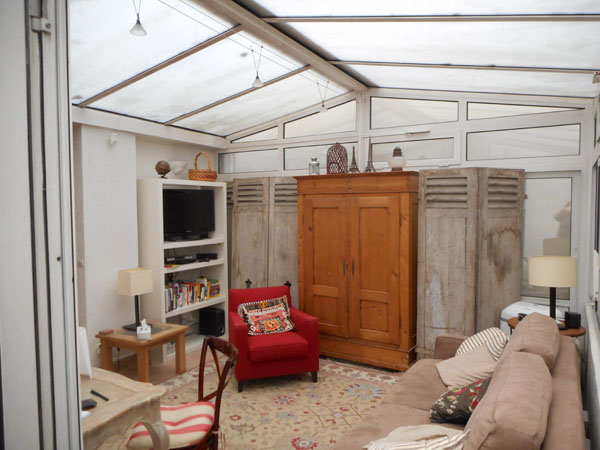 |
A fully furnished kitchen and small table. A glass door (open here) led to the tiny remaining "outdoor" space of the courtyard.
The only thing the apartment really lacked was a window. But we could peer up through the glass door and see the sky to get a hint about the current weather. |
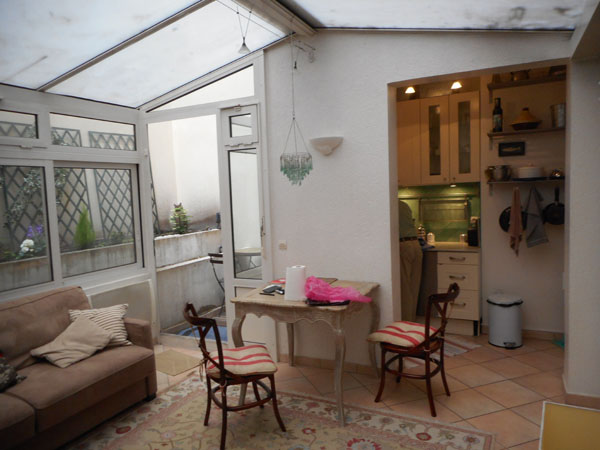 |
| The apartment was very thoughtfully decorated. Karen really liked the ornament hung over the table. |
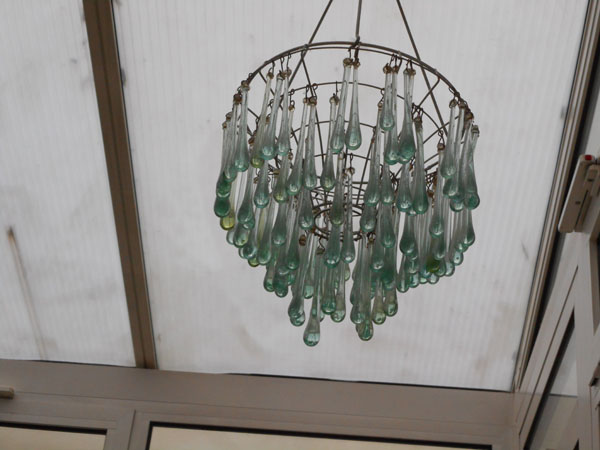 |
| The bathroom worked well. |
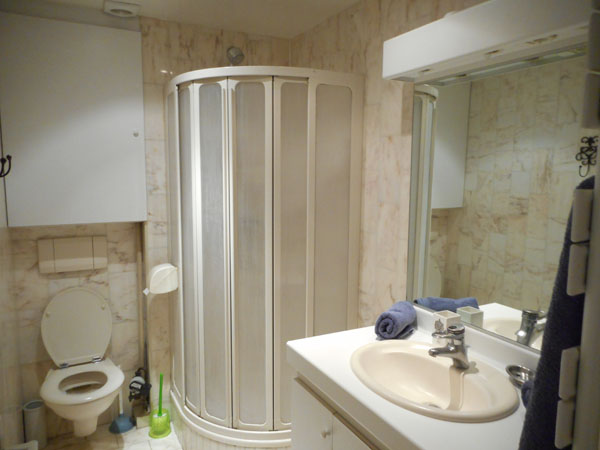 |
Three hooks by the door for wet coats and a comfy bed with a curtain for privacy if there were others occupying the folding sofa-bed in the living room. There were places to put our bags too. Here they're on the bed because we were just packing up to move across the hall. |
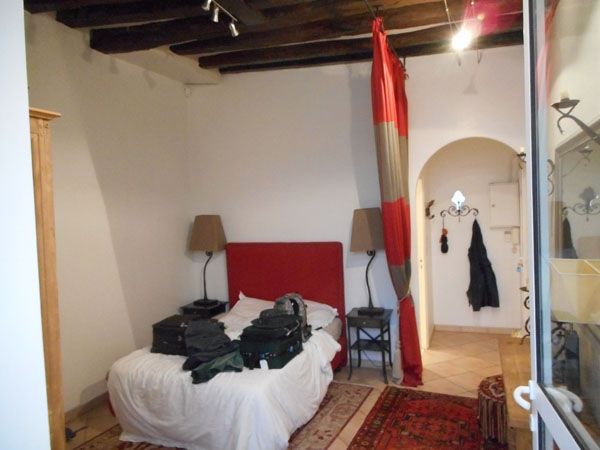 |
Due to the apartments' scheduling, we moved next door after 9 days. This second apartment was the one we really wanted when we saw it on-line because it looked out over the street. Both were just fine and we'd stay in either again in a heartbeat (if you are interested talk to Maria, mpatravel@outlook.com, http://mpatravel.kigo.net/). This is the view through its hall, with the door to the kitchen on the left. |
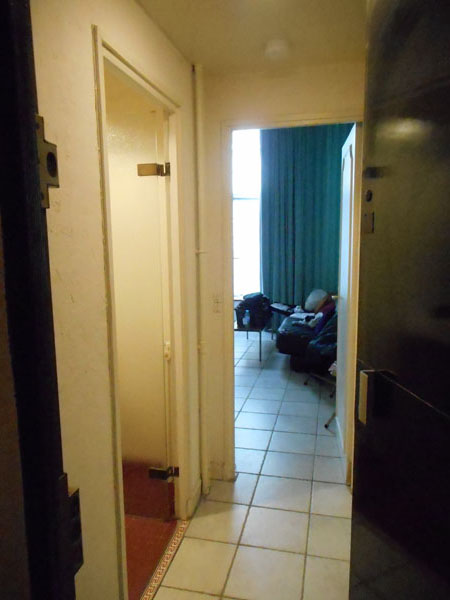 |
| This was a studio apartment, so it didn't have a separate living/dining area. Twin beds instead of a Queen, but we didn't drop ourselves into the gap too often. |
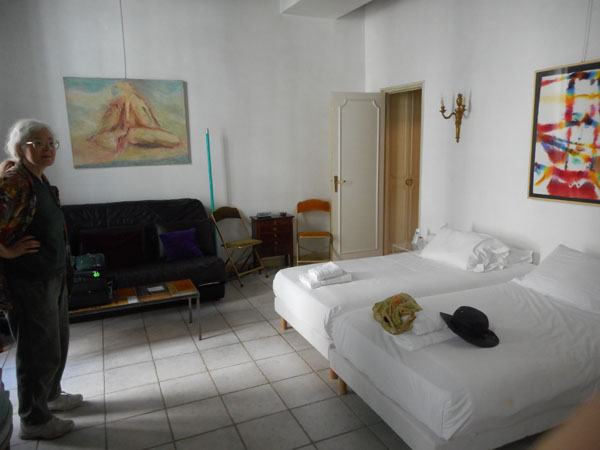 |
| Instead of a shower stall, it had a spray head on a hose, and a hook to hold it up on the wall. The shower door was a folding-door-like arrangement that really did manage to keep the water in the tub. One joy was near-instant hot water due to the proximity of the large water heater tank.
|
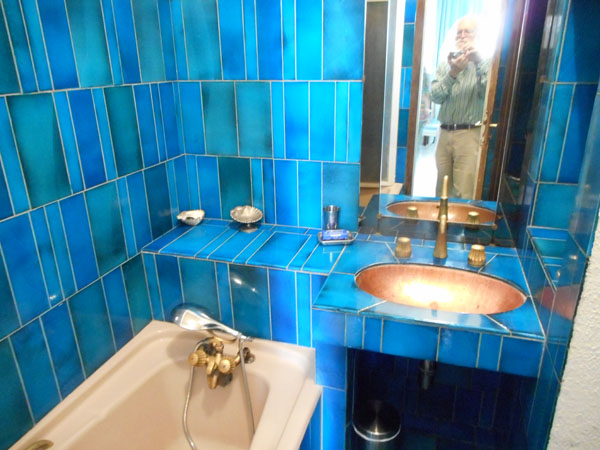 |
And, this being France, it also had a bidet. Unlike others we've met elsewhere in the world, this one didn't have a spray, leaving us a bit perplexedly amused. The manual (in the plastic pouch on the wall) didn't clarify things.
|
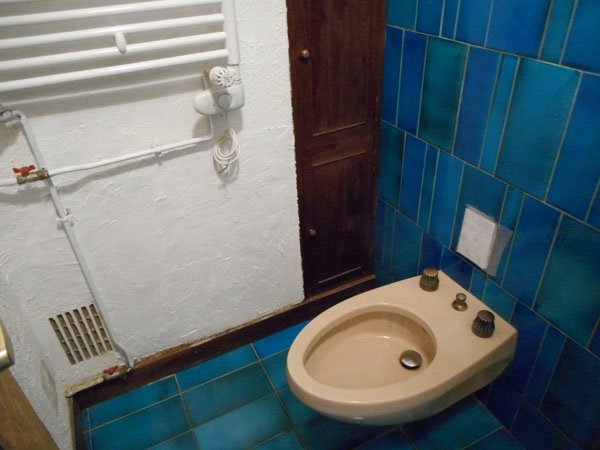 |
| In some very important points it was better than our first apartment. The kitchen and refrigerator were bigger and the microwave not so far overhead. Both apartments had a clothes washer. |
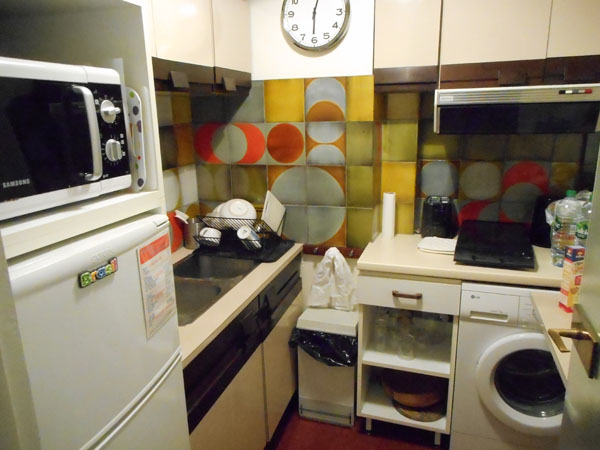 |
| The studio had more storage space than the first apartment. Since the floor was tiled, we didn't have to worry too much when drying the spun-to-barely-damp laundry. |
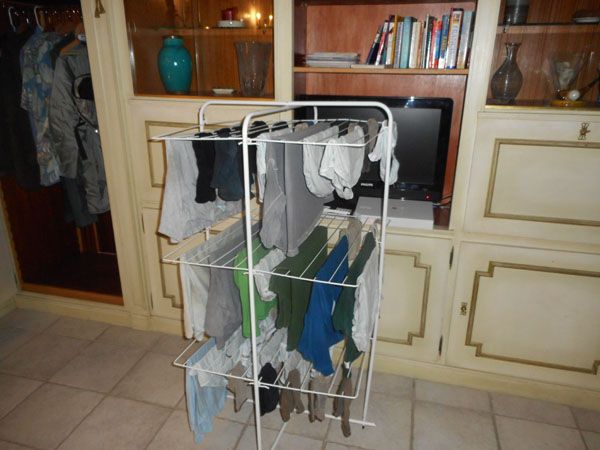 |
Although in Paris, we maintained our usual morning breakfast habit of oatmeal and cheese (Dick) or ham (Karen). The purple book is our full French/English dictionary. The other books on the table are our assortment of guidebooks. Each apartment also had a shelf full of handy guidebooks and maps. |
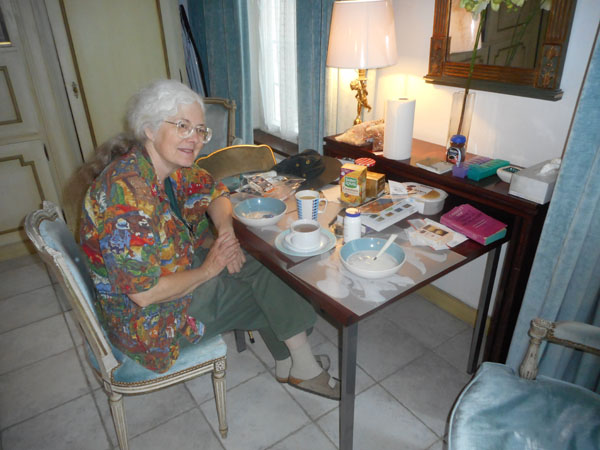 |
| The hat and checklist full of things to bring along before heading out for a day's adventure. |
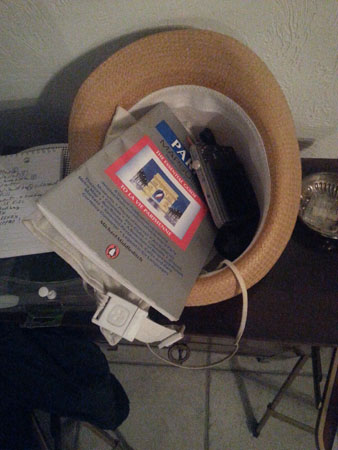 |
Immediately beneath our feet (and three windows) was this small grocery store. It was a real plus. They started their day at 8 AM, so the sound of their awnings rolling up was more of a gentle reminder that we really should get up, instead of a rude awakening.
But we did have to remember that the grocer, and most of the rest of the shops in our area, were closed on Tuesdays. In compensation they were open on Sundays (unlike many neighborhoods), since this was a tourist area. Some other areas were closed on Mondays. Many shops didn't open till 11 am; quite a few places closed from noon to 2pm for the traditional French long lunch.
The upshot of this is that we did a lot of window-shopping, returning during open hours if we were really interested. |
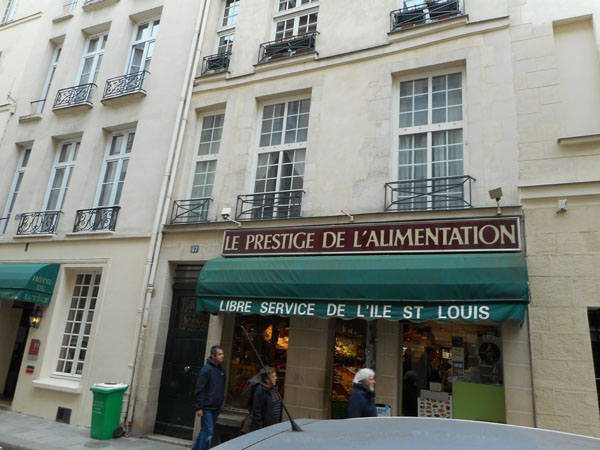 |
The big attraction of the second apartment was that we could open the windows to hear and see the street below. Closing them silenced things if we wanted quiet.
There was a boulangerie (bakery) across the street. We wish we could just step across our Seattle street for equally fresh bread.
|
 |
Two doors to the right of the baker was a cheese shop (brown awning).
Note that pedestrians pretty much "ruled" our street. |
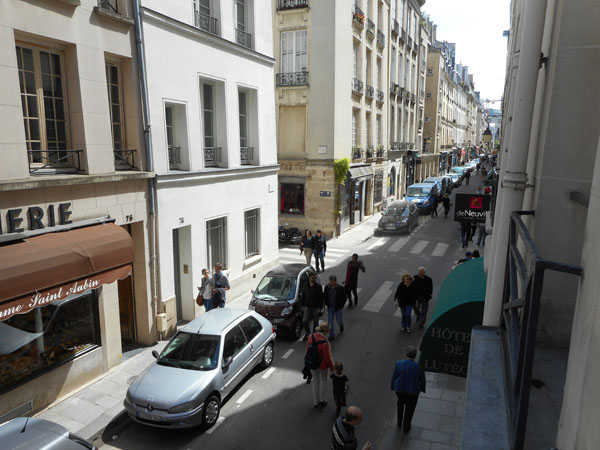 |
| Some evenings we would open the windows to hear wandering bands... some were jazz, some were mariachi, some just golden oldies. |
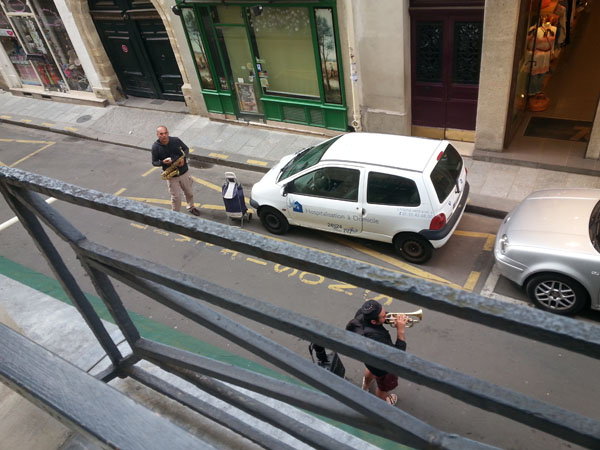 |
| Another evening there was a long procession of young people in uniform: many had passed before we thought to take a photo... |
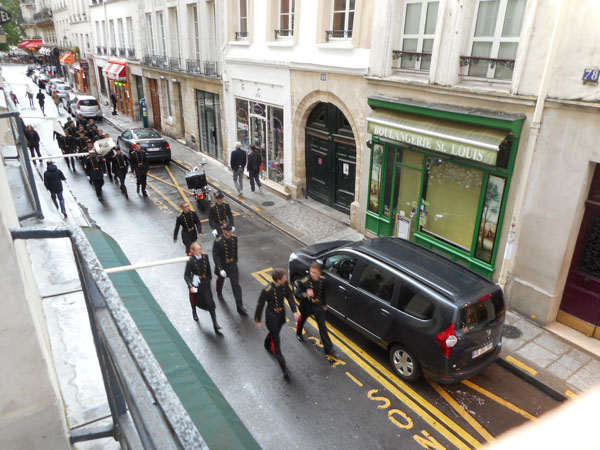 |
| In the morning there would be the grocer rolling up his grate and then the noise of a garbage truck. |
 |
| ...and the sidewalk washer. Why wash the sidewalks you ask? |
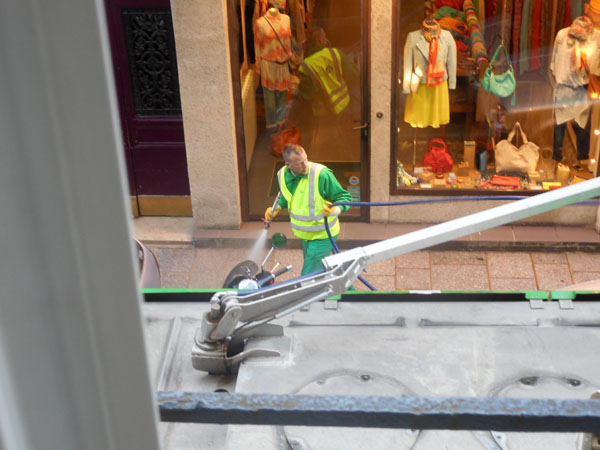 |
What Karen found most unexpected about Paris: men just wander up to the sides of buildings and "water" them right out in full view..
The city provides "pissours". |
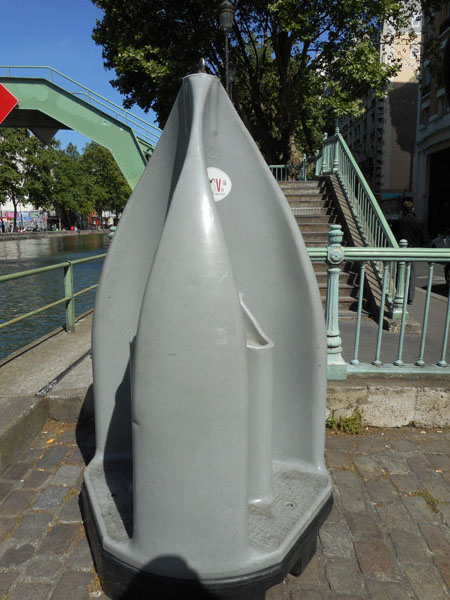 |
| And more private automatic toilets which wash down between uses. |
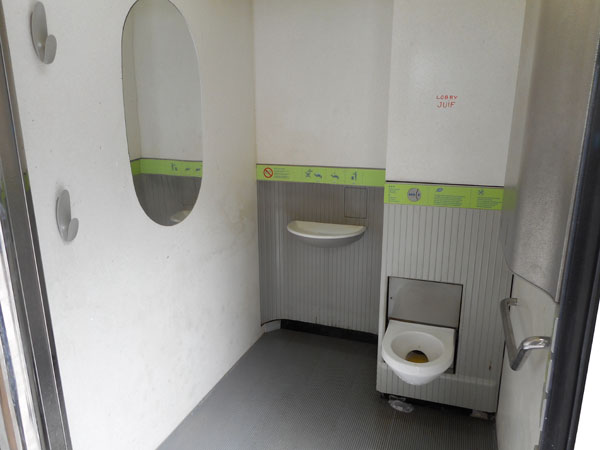 |
| Here's the wash truck sign Dick kept trying to take a photo of all month. The sign is part of the campaign trying to get people to pick up after their dogs. Roughly translated: "We try, but we can't be everywhere", it shows the wash truck acting as a very powerful doggy bidet. |
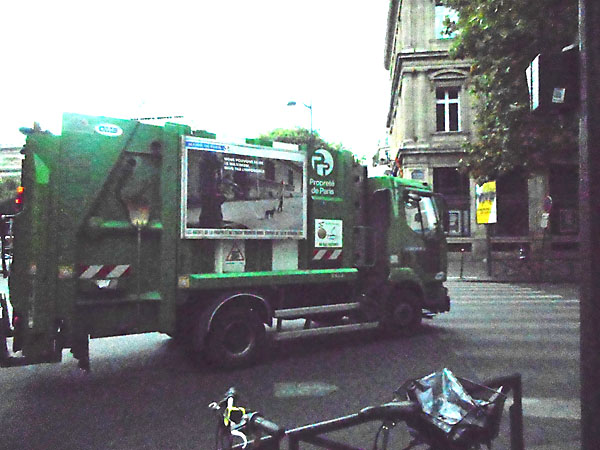 |
| Another morning we found a moving company set up outside our window. We'd wondered how they got furniture and appliances up and down the stairs. They don't: they move them with a portable elevator (the platform is just over the silver car in the photo) |
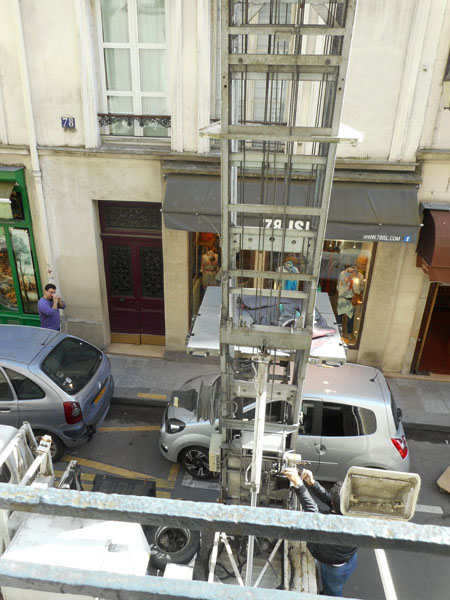 |
| |
|
During the day the street was full of tourists. A block up the street was famous Berthillon Ice Cream. Here's the line on a warm Sunday afternoon. The serving window is out-of-frame on the left. |
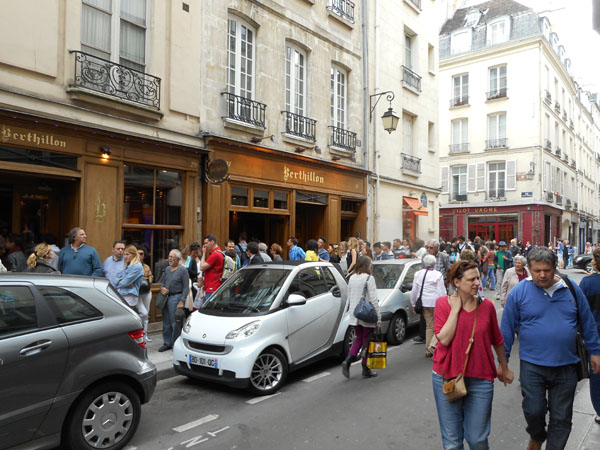 |
| And here's the much shorter line closer to home which served the same ice cream with the option of other (to Karen, better tasting) cones. Note who's in line. Frequently. |
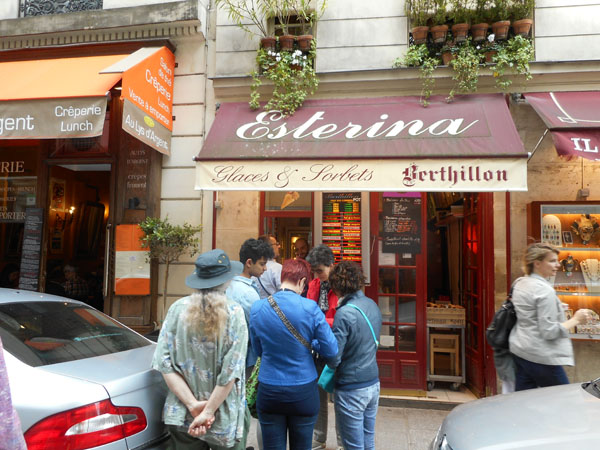 |
| Immediately to the left of that line was "Au Lys d'Argent", a galletteria. We ate here several times. Gallettes are like crepes but made with buckwheat flour and available with savory (meats, mushrooms, cheese, eggs) fillings. Very tasty (and they had good coffee ice cream too). |
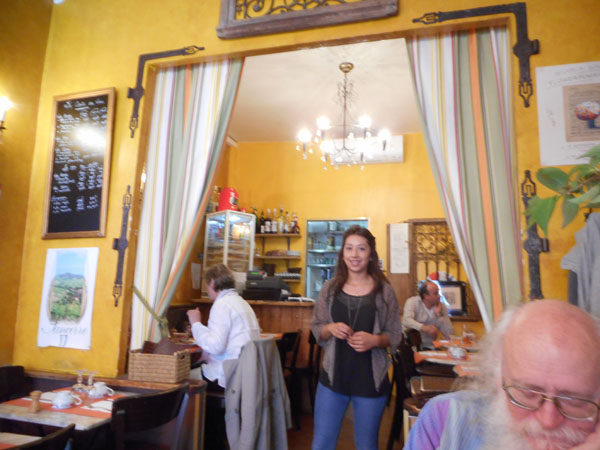 |
| There are restaurants on nearly every corner throughout the nearby districts. "Home" was between the Latin Quarter and the Marais. |
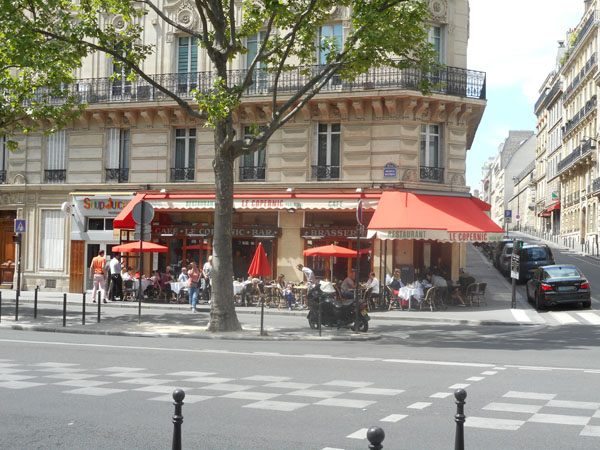 |
Here's Dick going through the menu translation routine at lunch.
Hmmm... volaille en sauce volaille. |
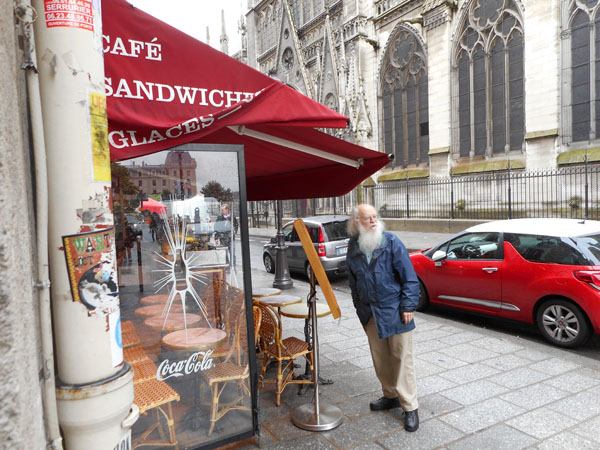 |
| And here's one that made us wonder where they got the idea. |
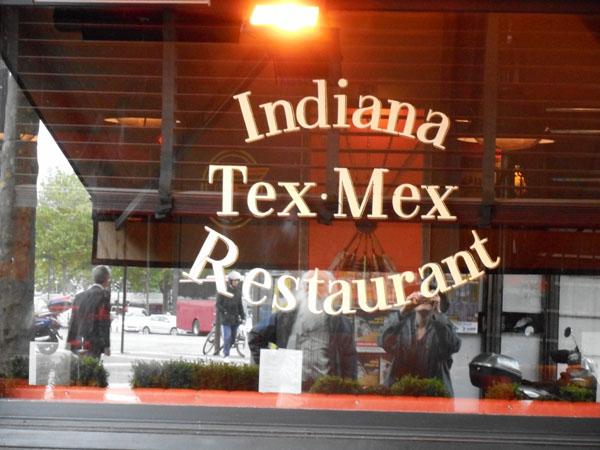 |
| We couldn't see what was Tex-Mex or Indiana about the menu. I'm sure that the US is as much a single culture/cusine to the French as France is to most of us on this side of the water.. |
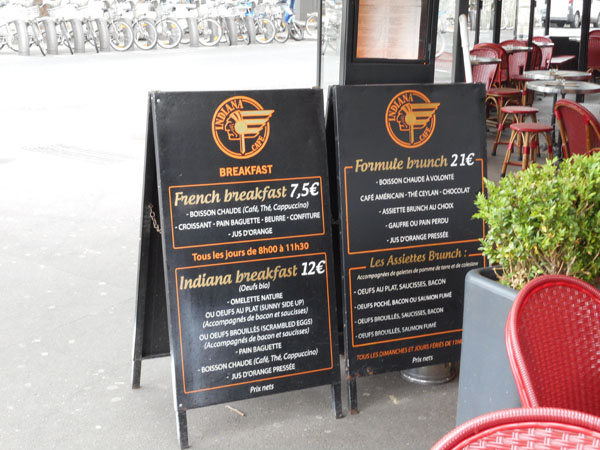 |
| No, we didn't sit at the inviting outside tables. There is no smoking allowed in the restaurants. This means the waiters and the locals stand at the doorways and sit at the outdoor tables chain smoking. And let's not even talk about perfume .... |
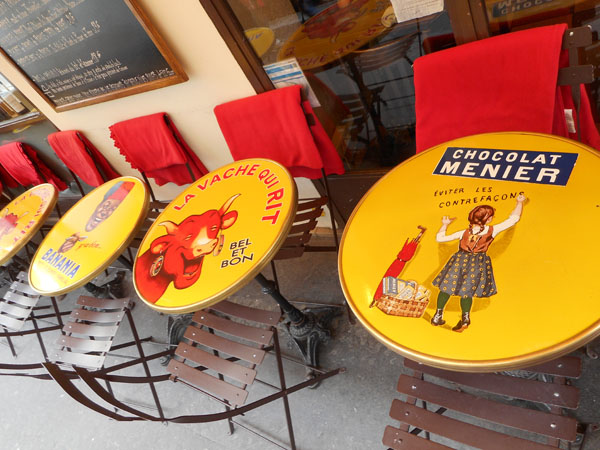 |
| Instead we ate at movie set cafes and usually had very good food. |
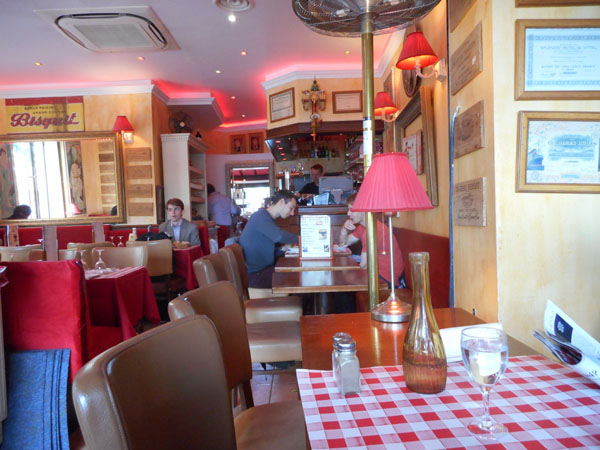 |
| The restrooms were always down very steep (and often dim) stairs. Frequently leading to mysterious passages (one featuring fascinating dance music from an adjacent African embassy's basement). |
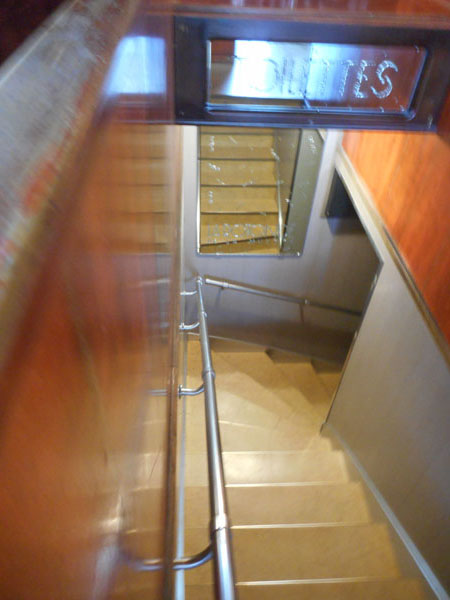 |
Frequently we ate at museums' cafes. Despite Karen's expression she quite liked the Musée Guimet's food (canard en sauce citron). Even the food at the Louvre was good and reasonably priced (about $25 for two at the fixed price cafeteria). Of course you could also go to the Louvre's very elegant restaurant where the food was probably --very-- good for twice the price, but we didn't do that.
At one point we did choose the 2nd most expensive restaurant in a neighborhood, and the food was noticably many cuts above our usual fare. |
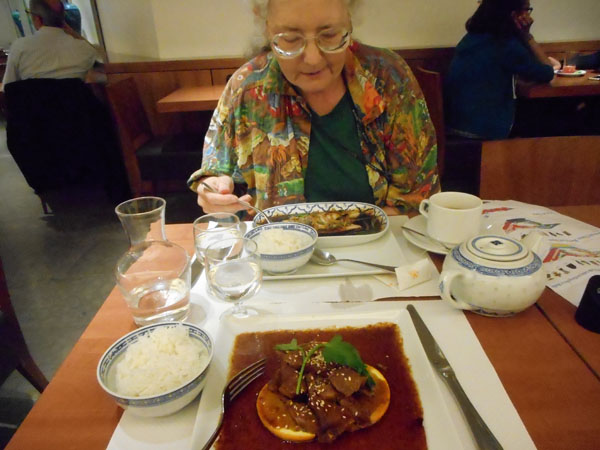 |
We sometimes just bought food from a stand in the park.
The crepe and gallette stand in the distance along the low end of the Champs-Élysées was staffed by a Cuban family. |
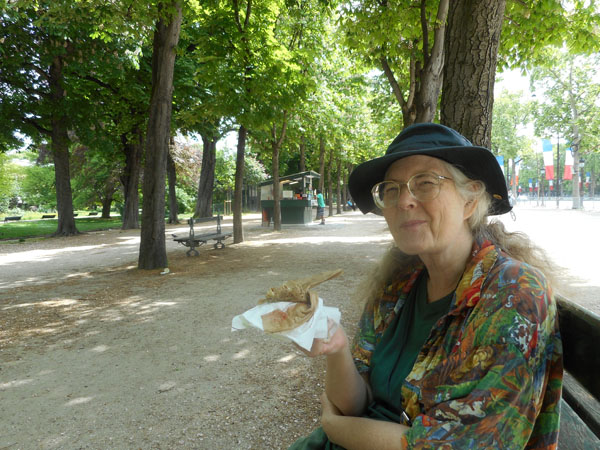 |
| At one point they were even giving away free drinks (Lipton Tropical Iced Tea). It was slightly overpriced. |
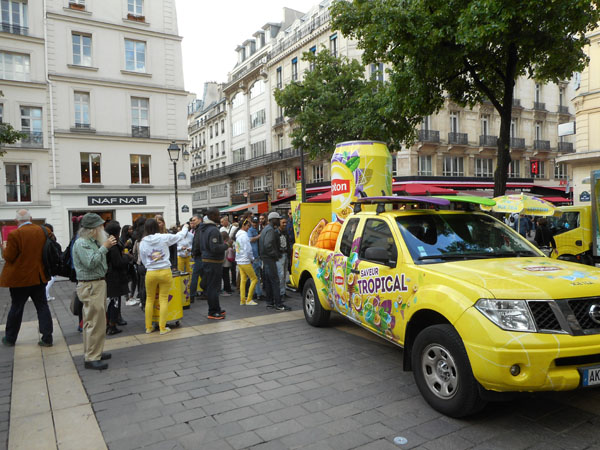 |
| At the end of many days we'd go home to a light supper of still-warm-from-baker's-oven bagette, pesto and cheese. We'd read up on the next day's outing, write today's diary and try to puzzle out words we hadn't been able to confidently translate during the day. |
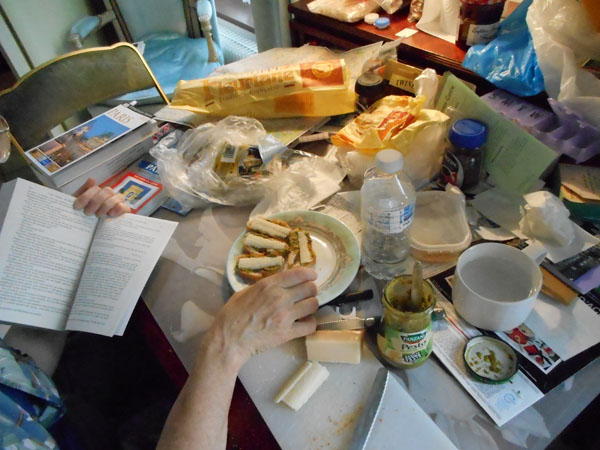 |
| A few nights we did go out after dinner. We could walk a block over to the edge of the island and just see the Eiffel tower. |
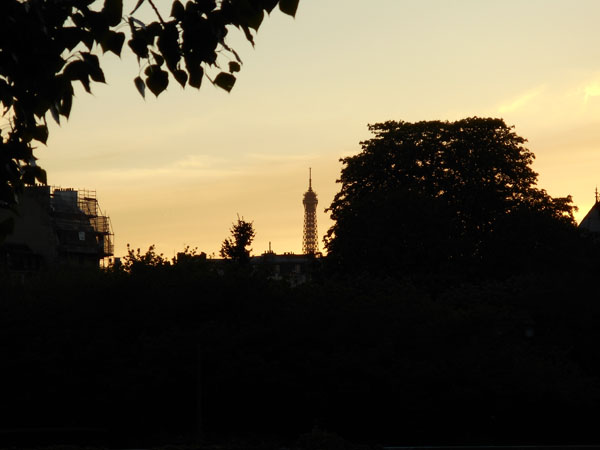 |
| The moon also put in an appearance |
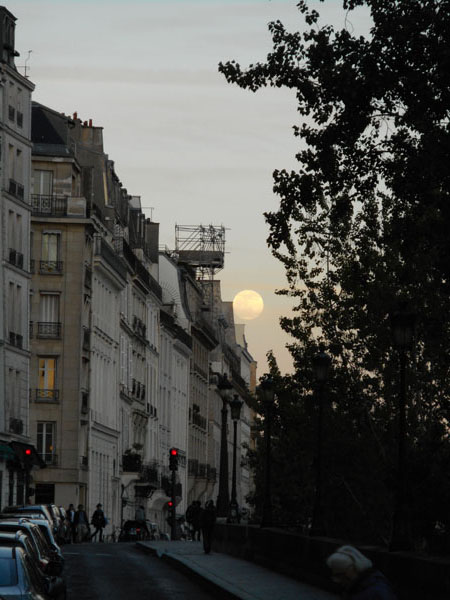 |
| The church is Notre Dame, one island downstream, and the tiny glimpse of Eiffel tower is about 1 inch to the left. |
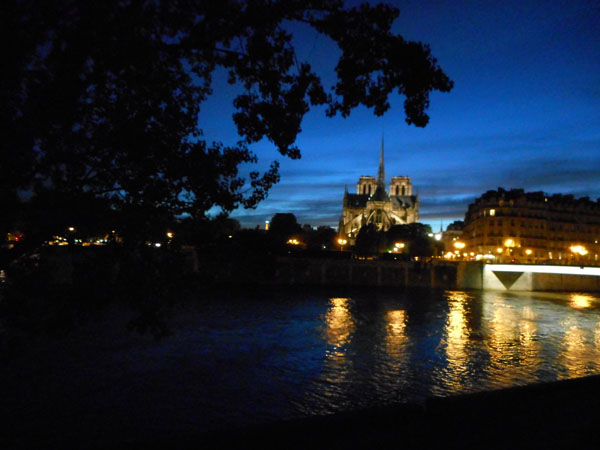 |
| On the hour Eiffel went through a twinkle routine. |
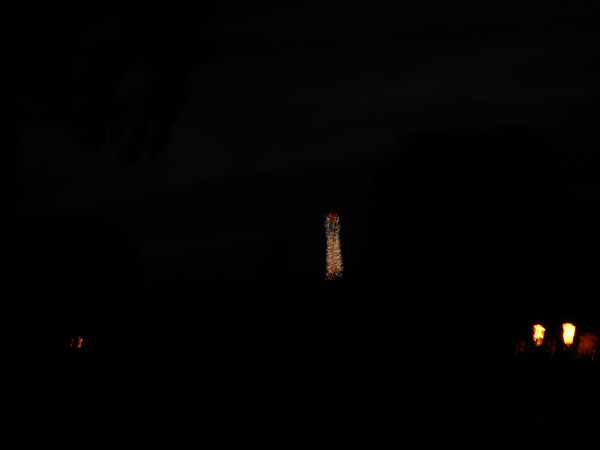 |
| Notre Dame was very much a part of our neighborhood |
 |
| The towers can be seen from almost all over the city if you get up high. Every time we passed through the plaza in front there were lines of folks waiting to go inside. And longer lines on the side to climb the towers. |
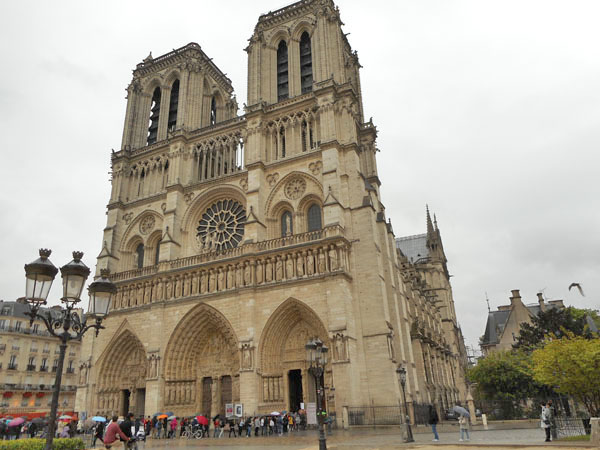 |
Well into our trip we finally went inside. The entry to the cathedral is free (but donations are welcomed). This seems a very active church which takes both its historical importance and its religious purpose seriously.
As with almost all churches and museums, photos without flashes were allowed. No Tripods. Please excuse the consequential low light blur of our indoor photos. |
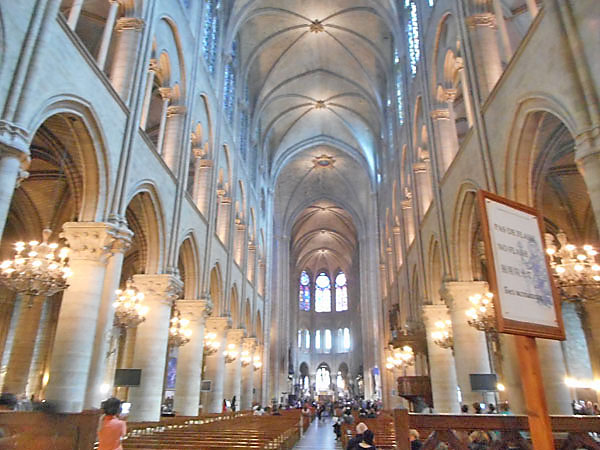 |
| There was a helpful model of the cathedral |
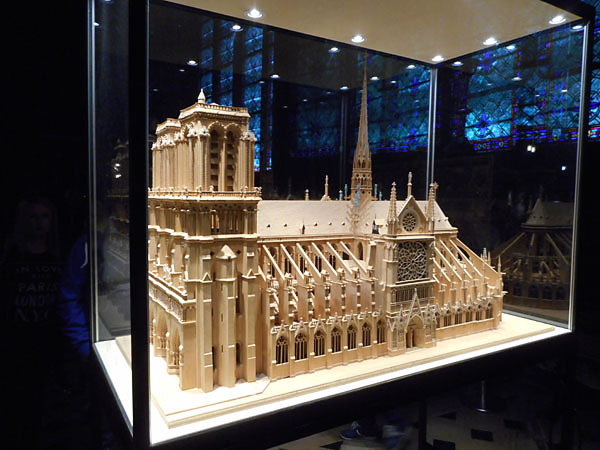 |
| You can easily see that the main roof is cross-shaped. |
 |
| Notre Dame's construction took centuries. There was a display of the process in 3 languages |
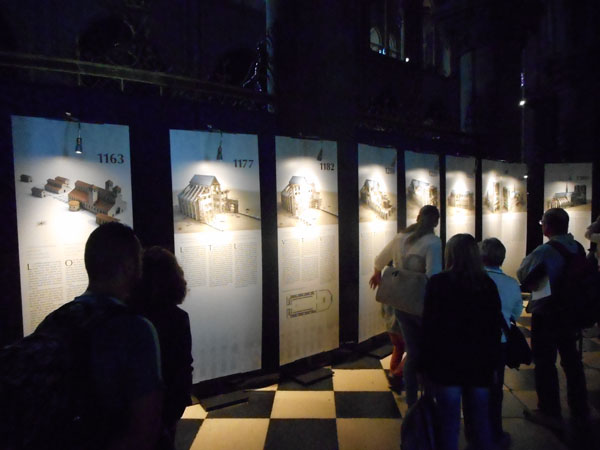 |
| The contemporary altar in the transept (center of cross-shape mentioned above) with "choir" (place where the choir, usually monks, sang the offices of the day) behind the altar |
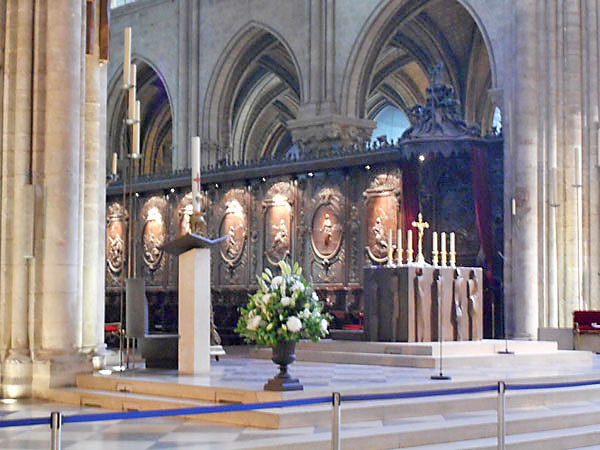 |
| The back of the choir has a restored carved wood screen |
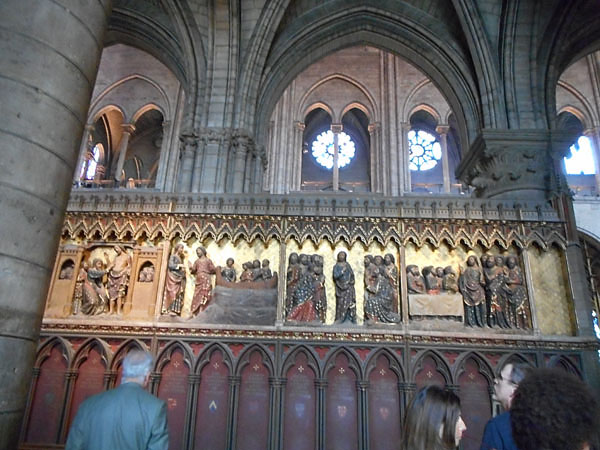 |
| There were several rose windows |
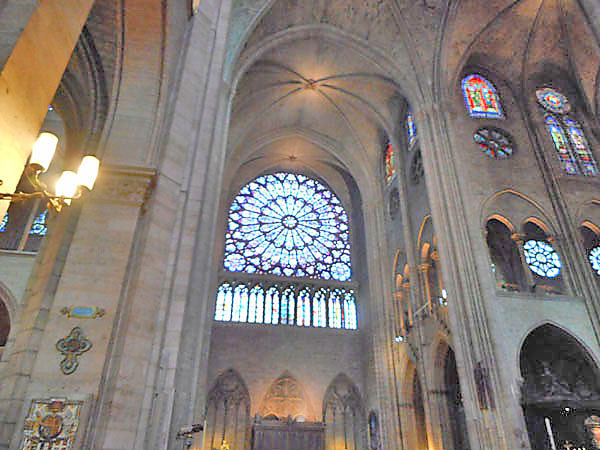 |
| |
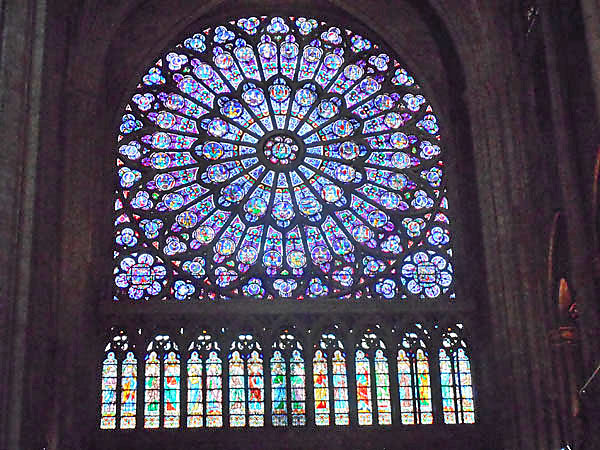 |
| including one behind the organ pipes |
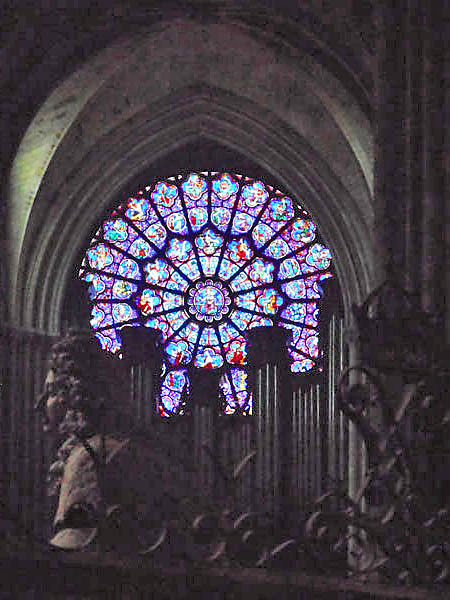 |
| several side chapels and altars |
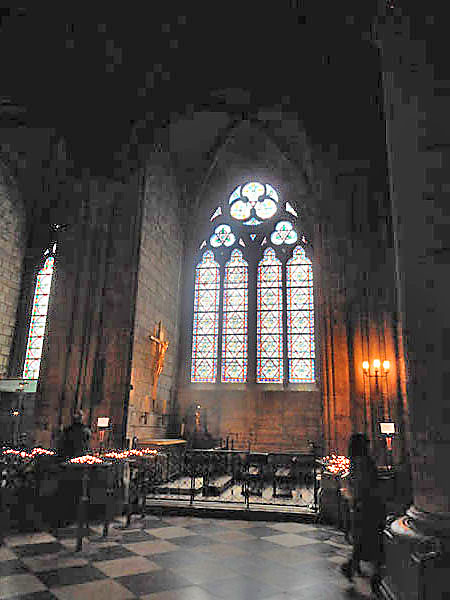 |
| and lots of stained glass, both traditional |
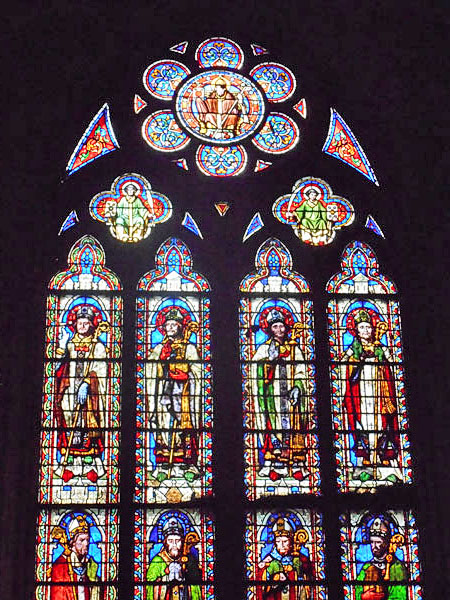 |
| and more contemporary |
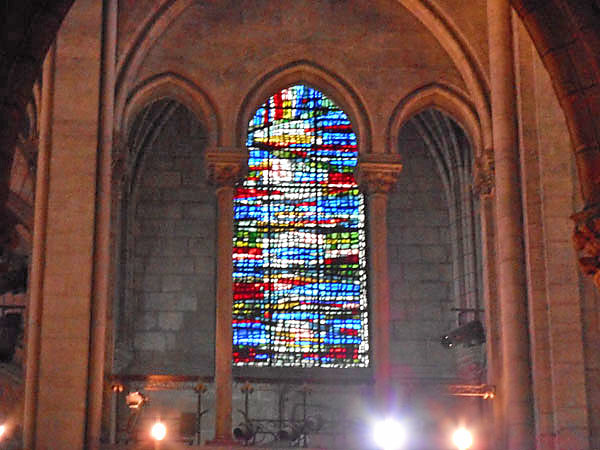 |
Various saints were commemorated in both English and French
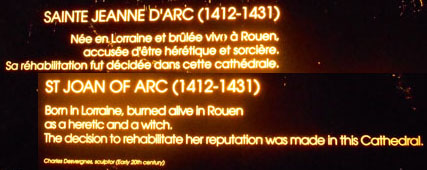
|
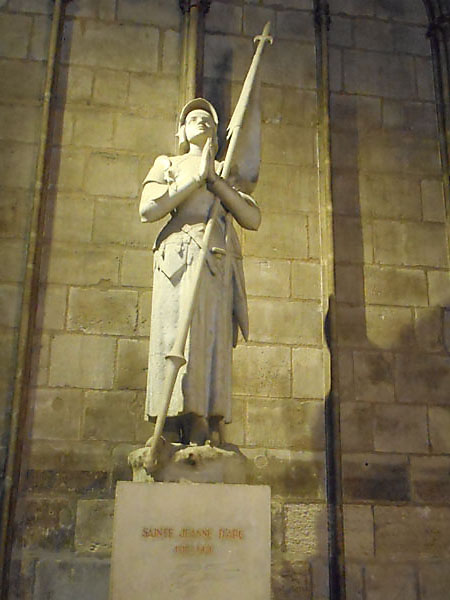 |
One could pay a small fee (3 euros) to enter the treasury. Well worth it.
A hall with stained glass depicting Paris' patroness Saint Genevieve (diverting Attila's Huns and supplying food during a seige) lead to... |
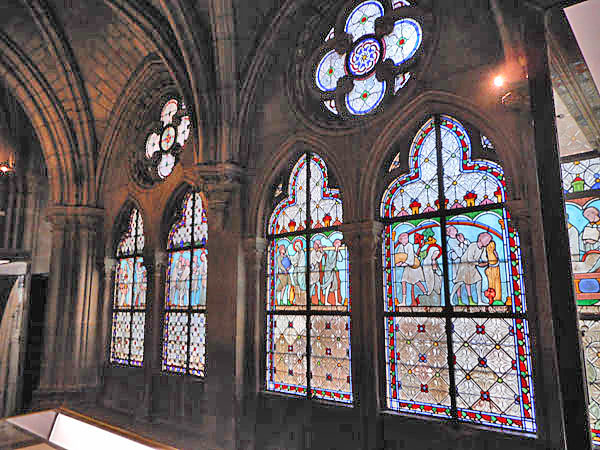 |
| ... several rooms with cases of gold and silver sacremental artifacts. Kings and revolutionairies saw these as fair game for melting down in times of strife. The treasury was completely emptied by 1792. Everything here now was added since that date. Napoleon made many donations. |
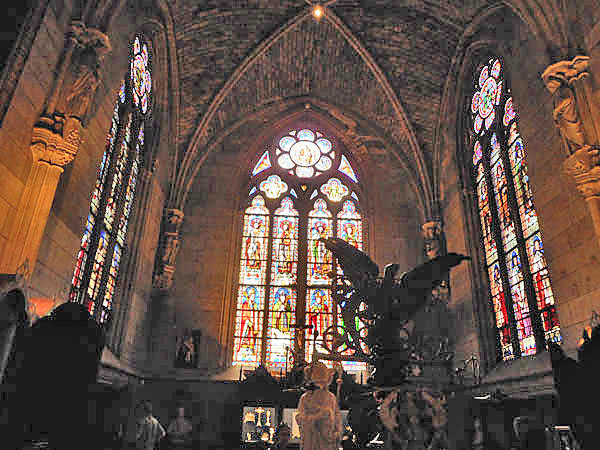 |
| More statues. Saint Denis, Paris' first bishop. Martyed by beheading, he then picked it up and walked on. |
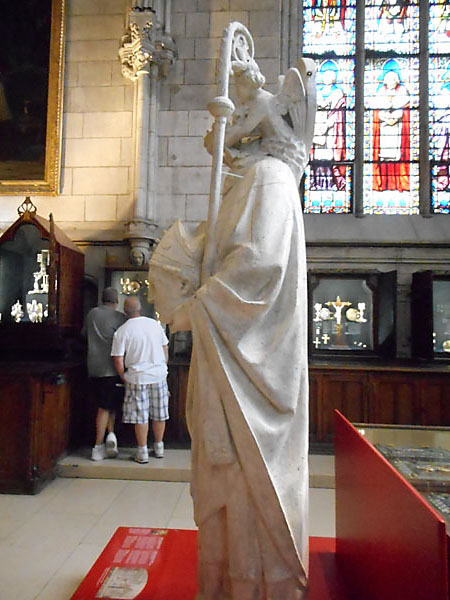 |
| crucifixes |
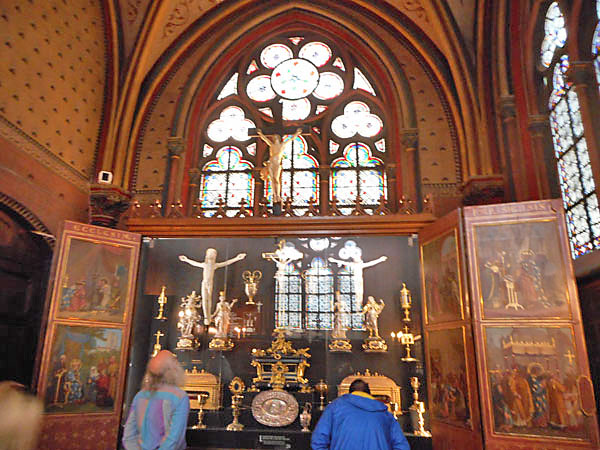 |
| reliquaries |
 |
| and crowns. |
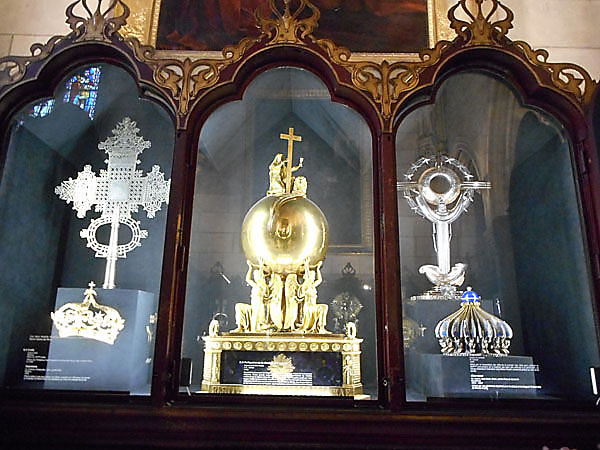 |
| Beautifully crafted vestments. |
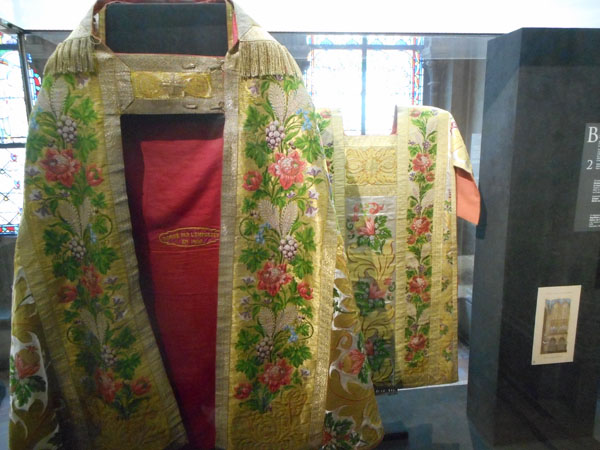 |
| Back outside in the center of the plaza is "point zero", the center of Paris. All street numbers "begin" here. All tour groups stand on it. |
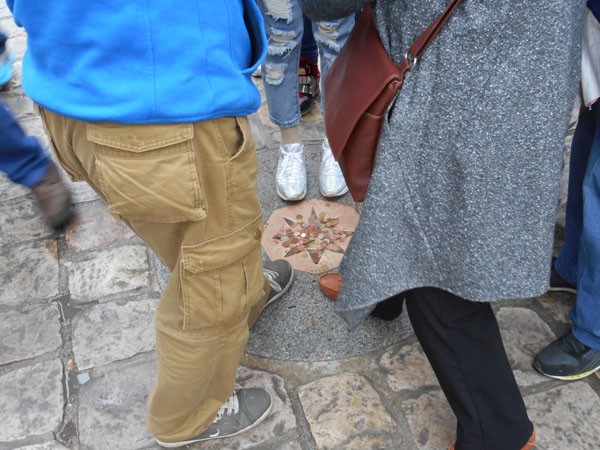 |
| On Notre Dame's south Seine-facing side there was a lovely little garden dedicated to Pope John-Paul II and world peace. We walked through it almost every day. |
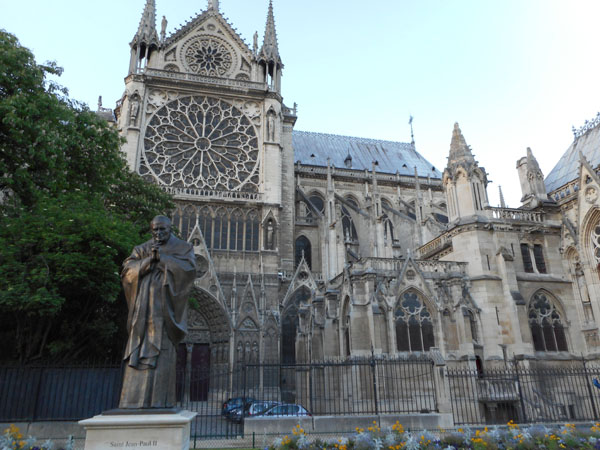 |
| During part of our stay they filled a quarter of Notre Dame's front plaza with a pavillion for a bread-making competition (white tent hiding behind the tree in this photo). The name "Festival du Pain" always brought a smile. |
 |
| As did the results: Examples of bread from all over the world |
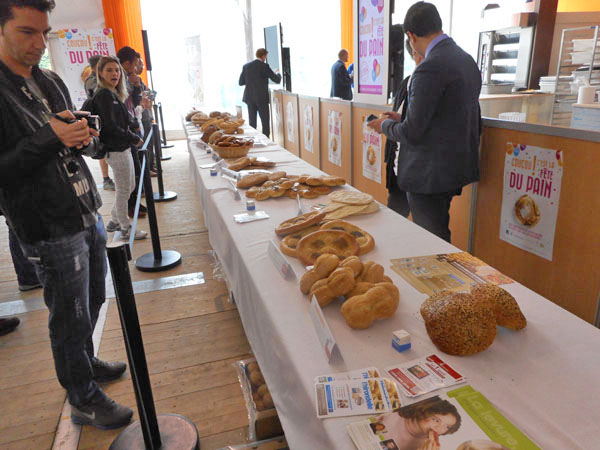 |
| On-site bread-making by bakers representing a different part of the city each day. |
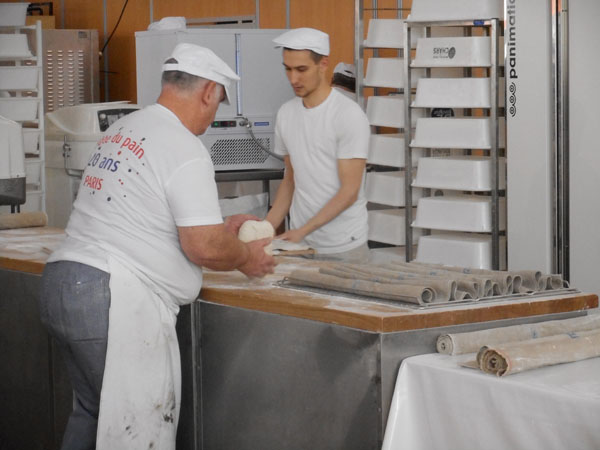 |
| On the weekend we noticed a band in the bandstand. Then we noticed the trees had been shorn. |
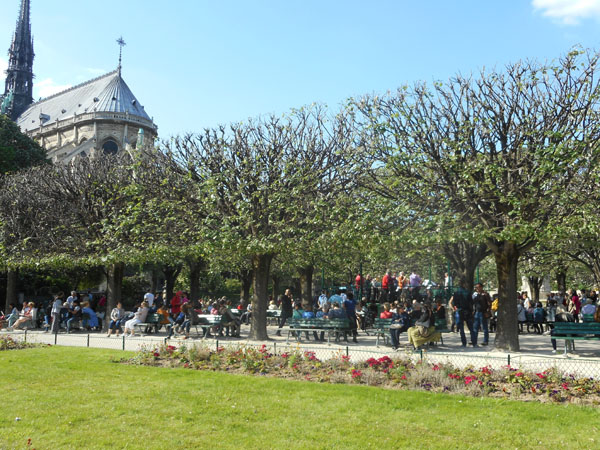 |
| Monday morning we caught them in the act: a mower for the sides of trees. A different machine does the tops. As we wandered through other parks it became apparent that the cube-shaped trees in the French paintings were not just the artist taking liberties. |
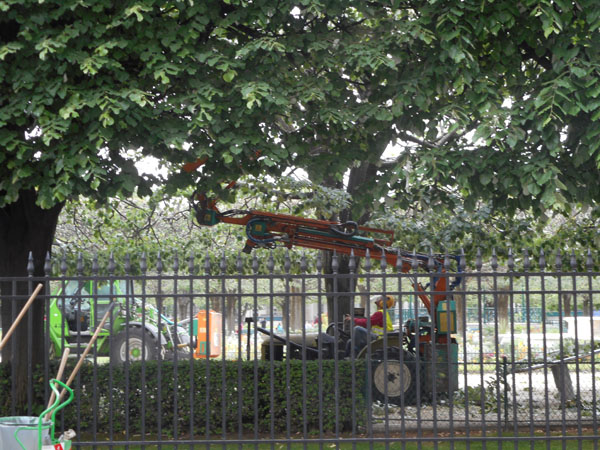 |
| Another major element of the neighborhood is La Seine. Here you see the upriver point of Ile de la Cite. The hole in the tip is the window of the Holocast Memorial. The tree on the right of the frame is on "our" Ile St. Louis (our night shot of Notre Dame and Eiffel was taken from there). |
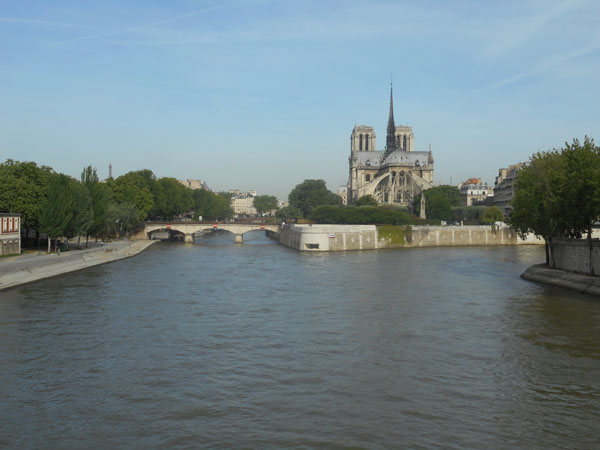 |
| Even though it is crossed by many bridges the Seine is still a working river. We saw about as many boats carrying cargo as tourists. |
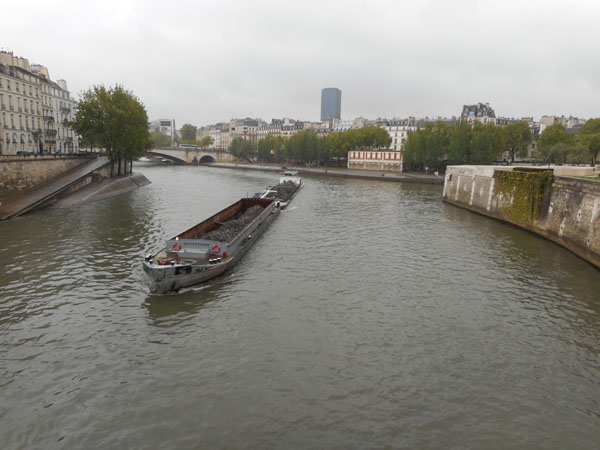 |
| Here a tour boat turns at the end of its run. An impressive feat given the flow of the current, the length of the boat, and the width of the channel. We never got out to those more modern buildings (the Bibliothèque Nationale de France (National Library). But note that despite most of our photos, Paris has some modern sides, spots and periphery. |
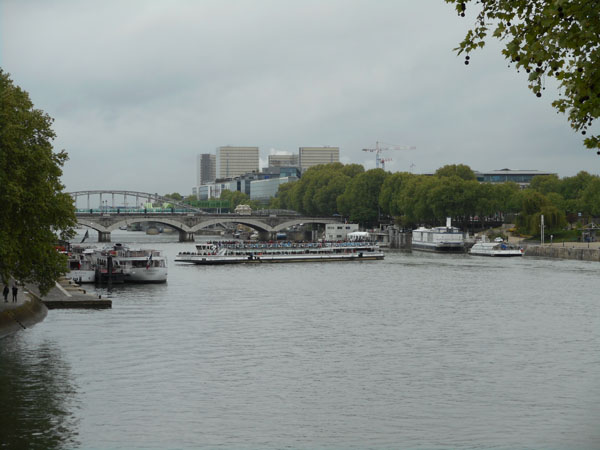 |
| There were all sorts of boats moored along the river. |
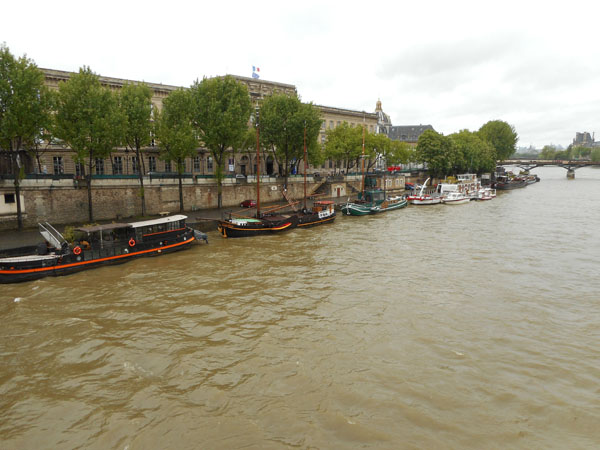 |
| Any sunny day people were out picnicking along the banks. |
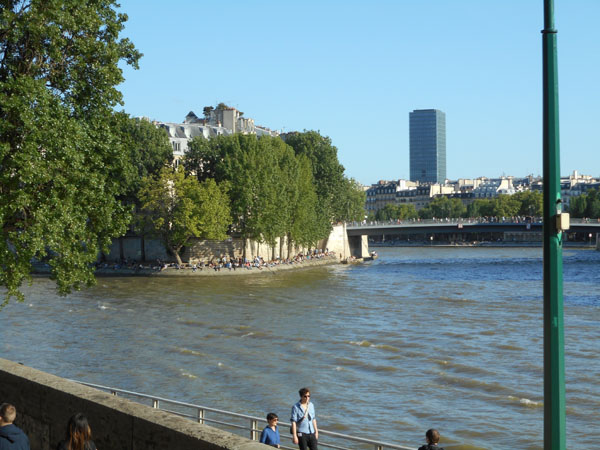 |
| Ile St. Louis in the early evening. |
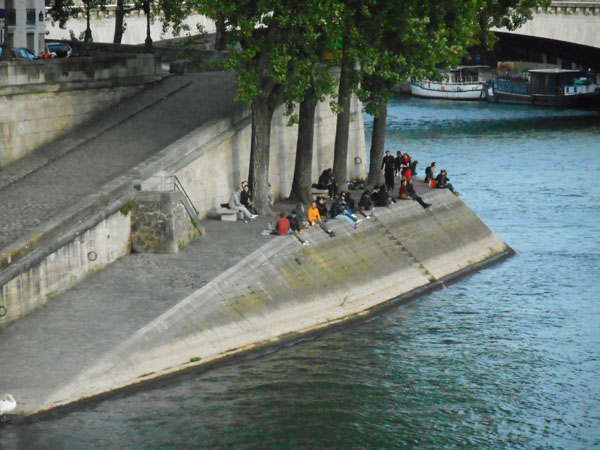 |
| Further downstream we found simple interesting benches (and a fashion photoshoot). |
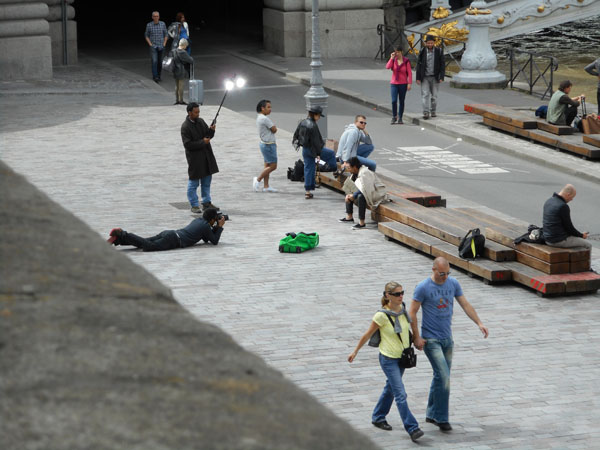 |
| Even a boxing lesson |
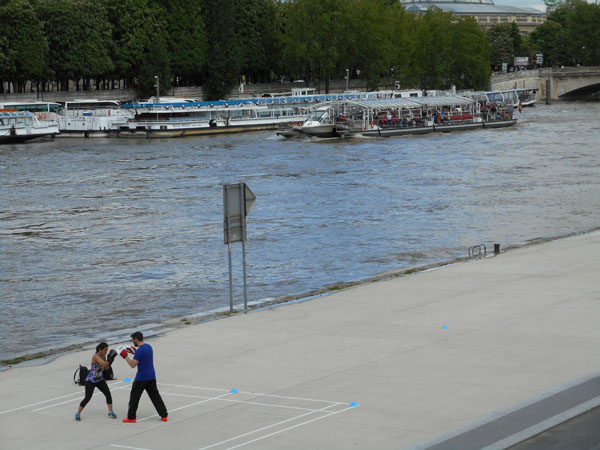 |
| and a pop-up resaurant |
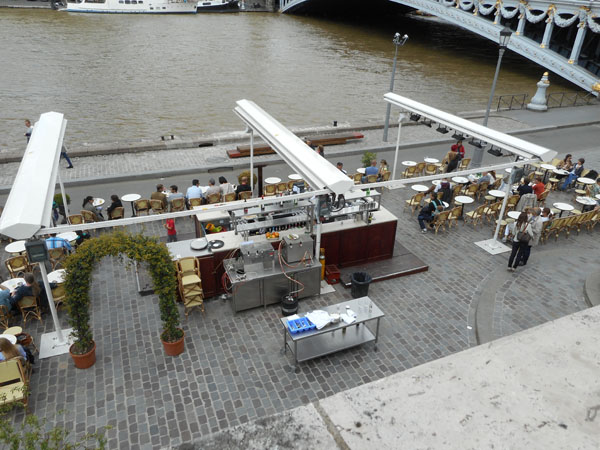 |
| And wedding photos being taken. |
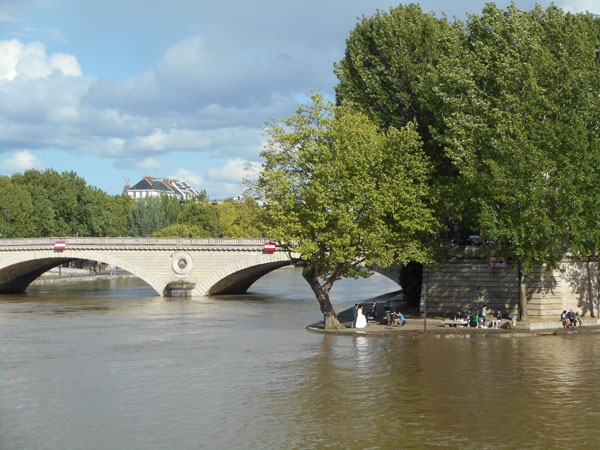 |
| Lovers leave something too: all the things on the bridge railings are padlocks. |
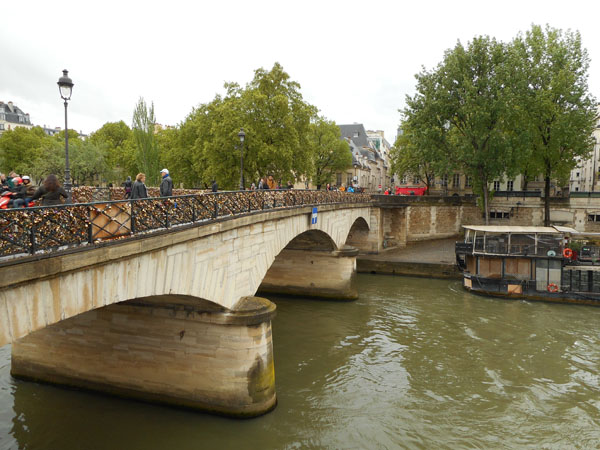 |
| The shops along the banks sell the locks. People write proclamations of their enduring love on them and then lock them on the bridgework and throw the key in the river. |
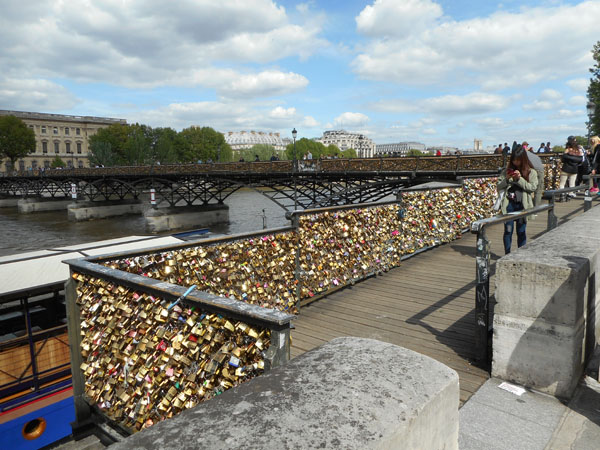 |
| One of the bridges is so covered with locks they are afraid for its structural integrity and have put up barriers (which were of course instantly covered with graffiti). |
 |
| The pedestrian bridges are also gathering and entertainment spots. Here's a "human statue" and his coin can. |
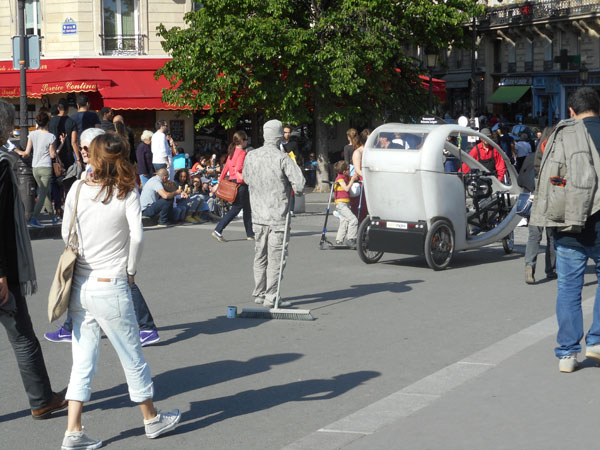 |
| While we were there the river flooded |
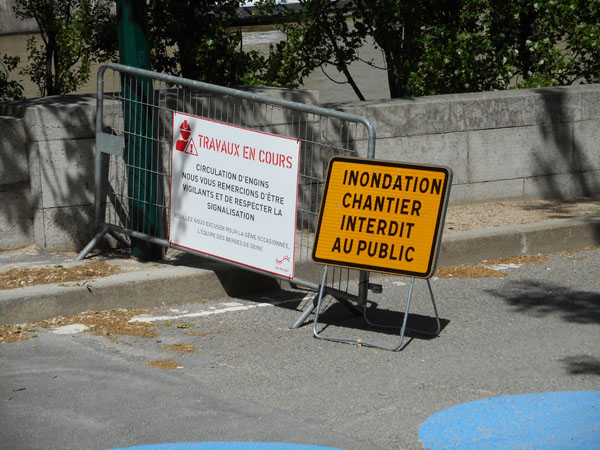 |
| The "batobus" ramps were underwater so they stopped running. |
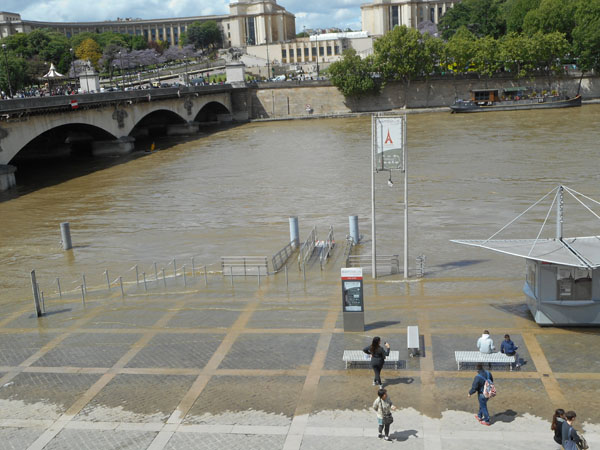 |
| Some of the other tour boars were still operating with ramp extensions |
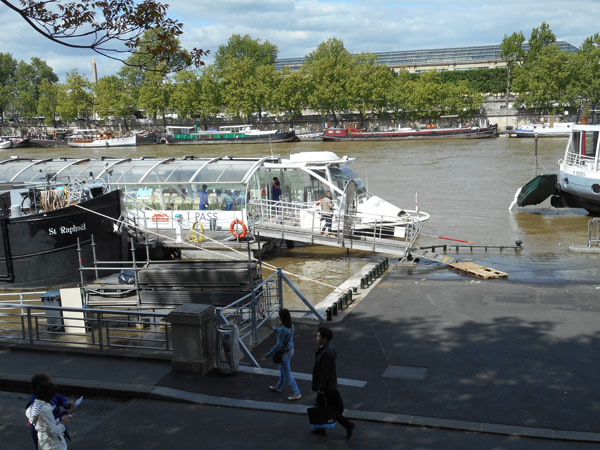 |
| The usually moored boats seemed unaffected but also unreachable |
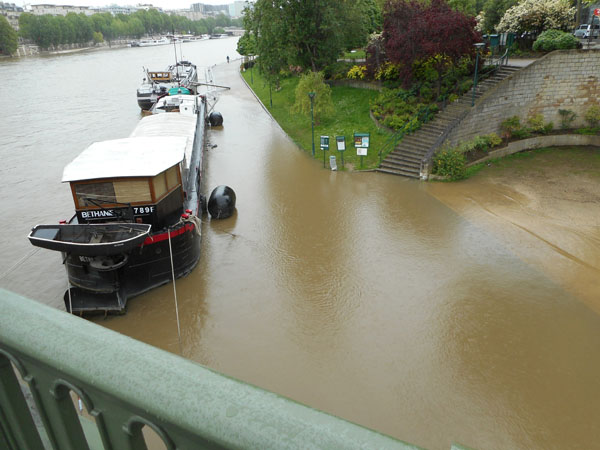 |
The tip of our island was several feet under water.
(Remember the earlier "wedding photo"? Same tree.) |
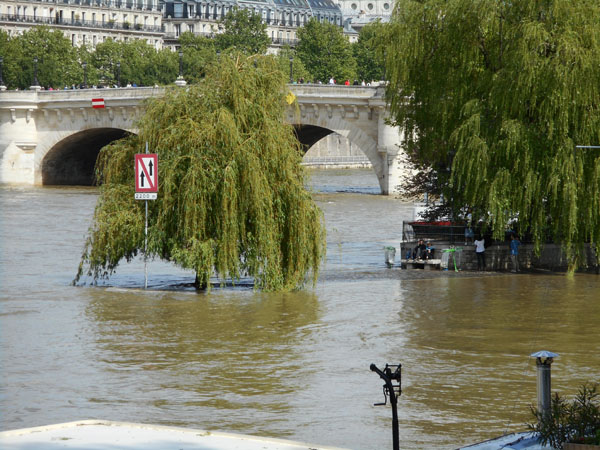 |
| A week or so later the willow re-emerged when the Seine dropped about 8 feet. |
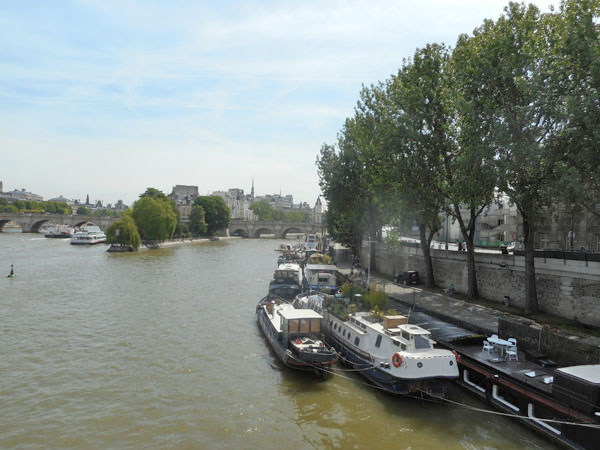 |
| The tour boats went back to letting people ride on top and the water-side roads re-opened. |
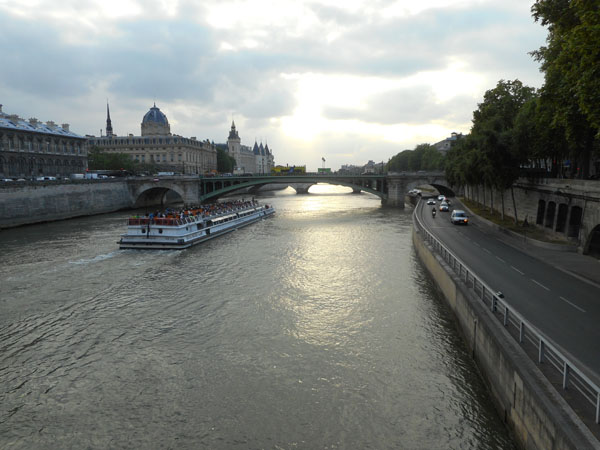 |
| A classic part of the riverbank scene are the booksellers. Their "shops" are metal boxes perched on the sidewalks' concrete walls. Here you see both closed and open stalls. |
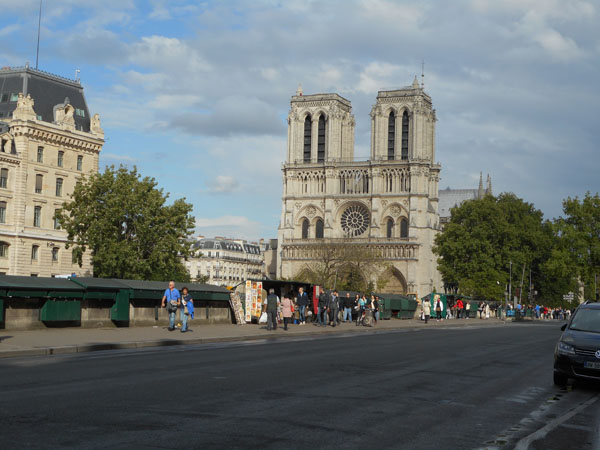 |
| Just beyond Notre Dame on the left (south) bank was Shakespeare and Company, the famous English language bookstore. We were slightly disappointed to find that it primarily sold new books now. Its used-books selection was limited to a few roll-around bins out on the sidewalk. However... |
 |
| Abbey Books, a few blocks away and run by a Canadian ex-pat, got our full booklovers' approval... |
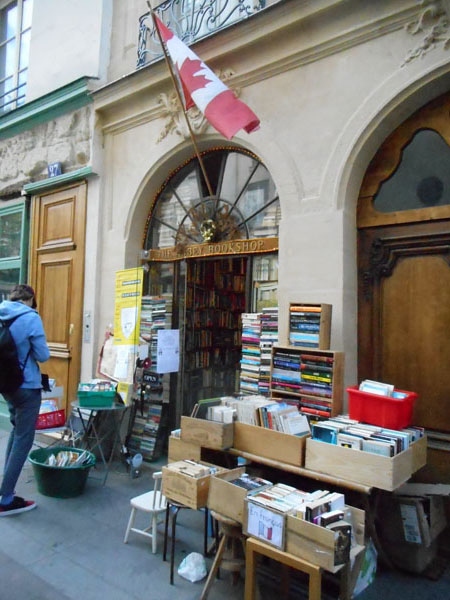 |
| the main floor was full (the visible shelves are on rollers to reveal an entire second depth of stuffed shelves behind) |
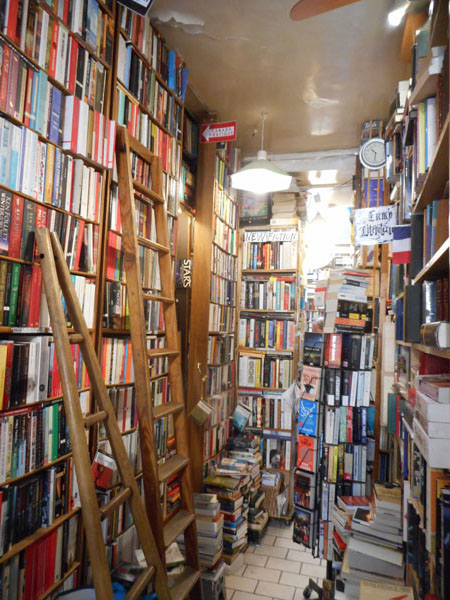 |
and the basement more so.
Truly a shop where you can't hope to find a specific book, but one in which dozens of interesting titles will find (or fall on) you. |
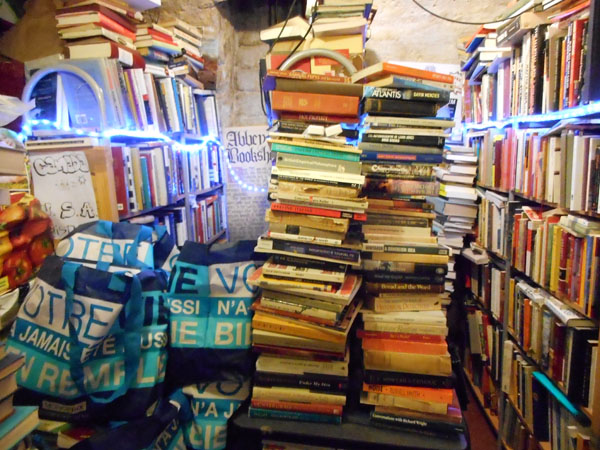 |
| Escaping with only a few books (per visit), just beyond we find a full tourist food haven hiding around Place St Michel. |
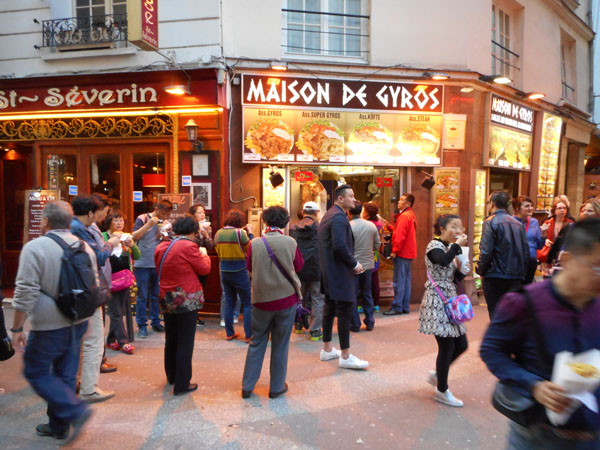 |
| Several blocks of pedestrian warren specializing in what tourists think Paris should be offering them for food. |
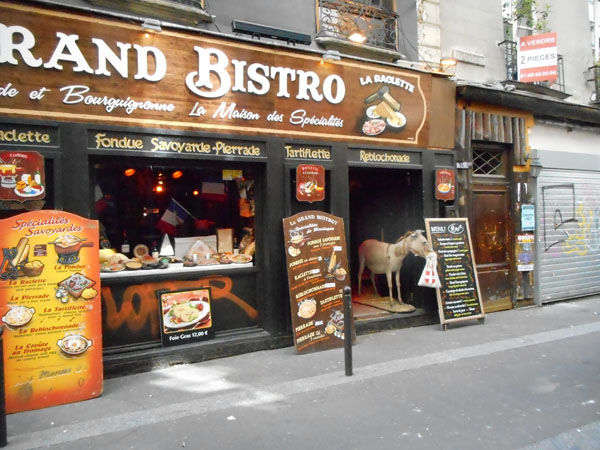 |
Leaving Ile St Louis to the north put us on the right bank of the Seine. Things were usually a bit quieter in this end of the Marais district (especially on a damp morning). The tea shop is only beginning to set up their outdoor seating.
This is Rue des Barres, behind Église Saint-Gervais. |
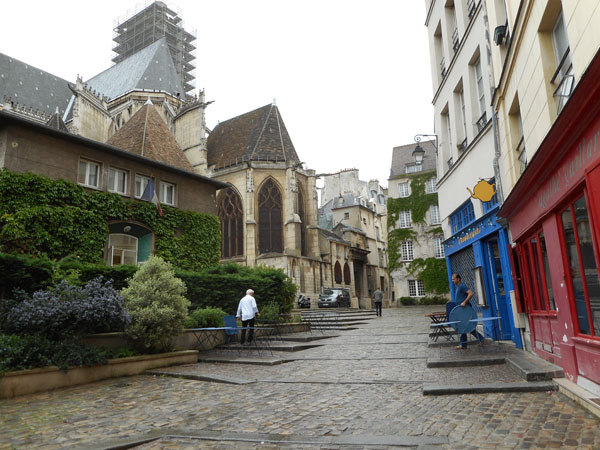 |
| A block or two further west brought us to the Hotel De Ville (city hall). There was almost always something going on. On our first evening they were cleaning up after a basketball competition. |
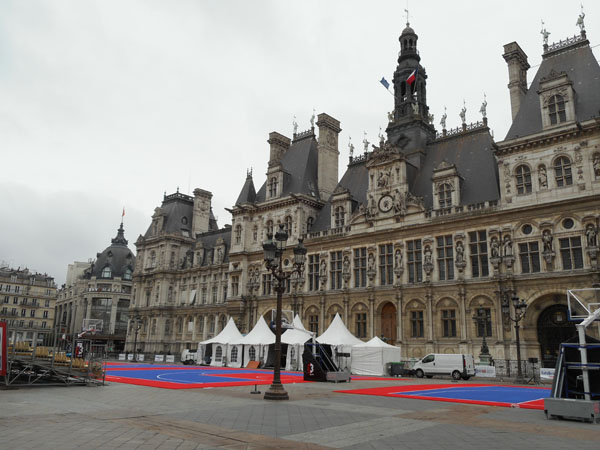 |
| A day or two later different tents were erected for something we never did figure out. No obvious signs appeared, and a day later the tents were being removed. |
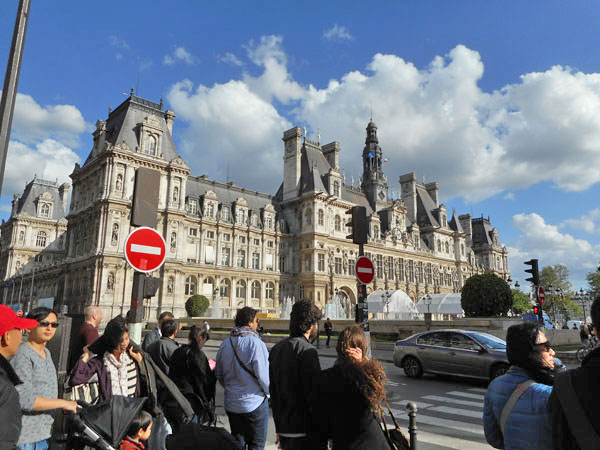 |
| One morning we stumbled upon an honor guard being assembled. We stopped and waited a few minutes to see what was going to transpire. |
 |
They were welcoming the president of Singapore.
The motorcade appeared, turned into the Hotel's gates and disappeared... |
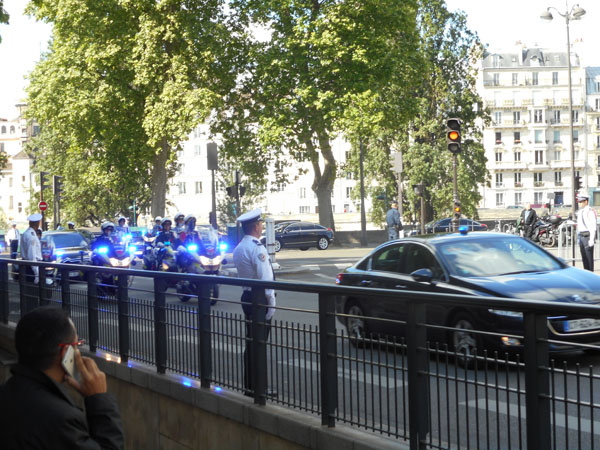 |
... after which the guards colorfully marched off.
The whole thing took about 20 minutes. |
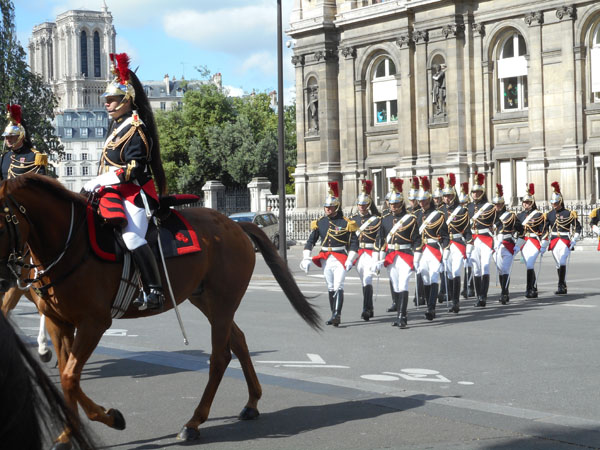 |
On another corner of city hall's front court there is a two story carrosel, with frequent other entertainment like this bubble blower.
Yes, that's Notre Dame in the background. |
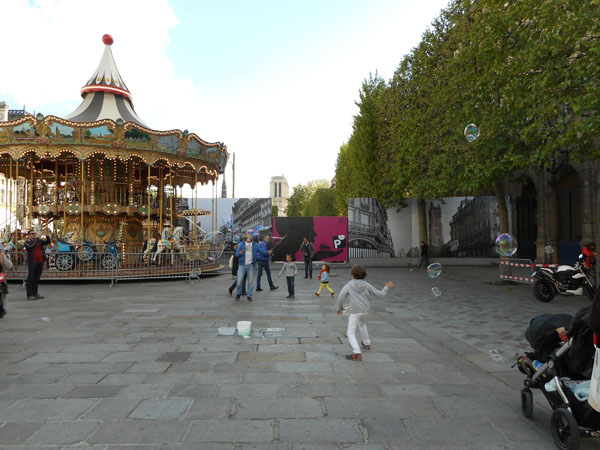 |
| Tucked on the Hotel's river side there is even a little hidden rose garden. |
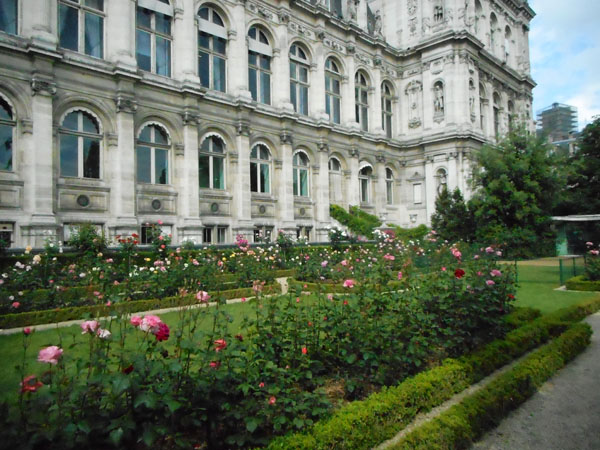 |
| Back to the Left Bank to a full blown flower market. We were told it is the last flower market in Paris. |
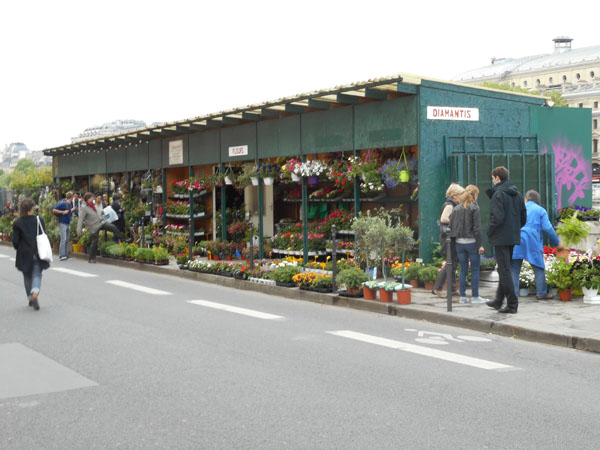 |
| On Sundays it turns into a pet market, too. |
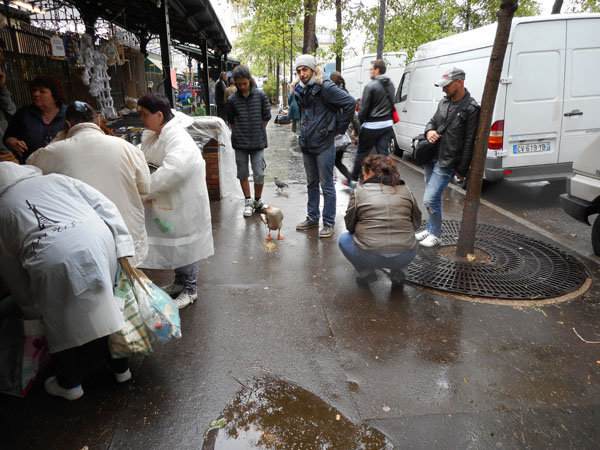 |
| Speaking of markets, all over the city we would see pole and rolled canvas constructs like this. |
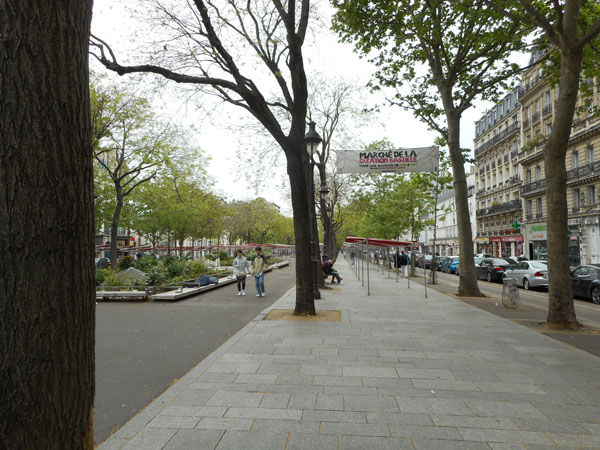 |
| Which in the morning would turn into this. |
 |
| Some had a more permanent look. |
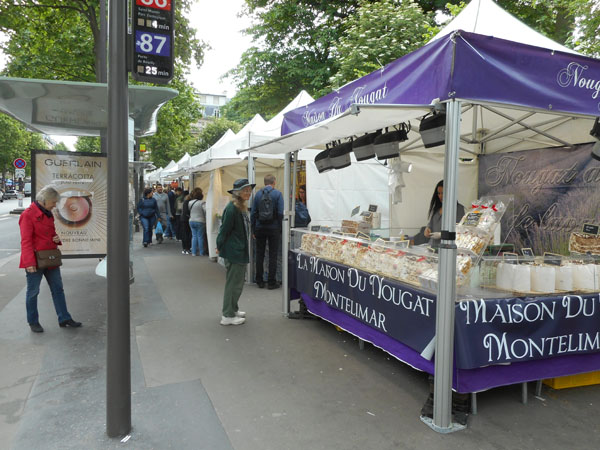 |
| Church concerts were another event posted and hosted all over town |
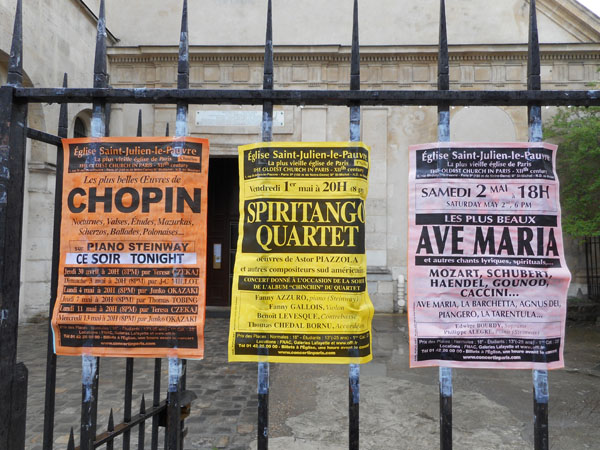 |
How did people get to events? Many walked as we did.
Dick is not taking a Parisian lunch hour with the rest of them, merely getting ready to take something out of his shoe and get to walking again. Really. |
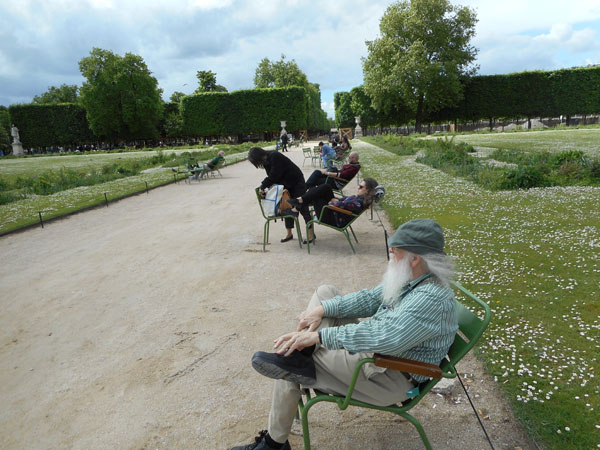 |
| We also took the bus sometimes. |
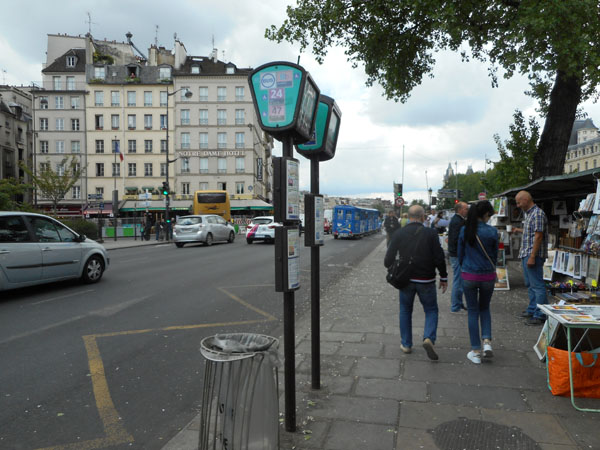 |
The signage was very good.
Reduced-fare ticket books (carnets) were sold in all tabacs (smoke shops... more like the 7/11 niche in the US) |
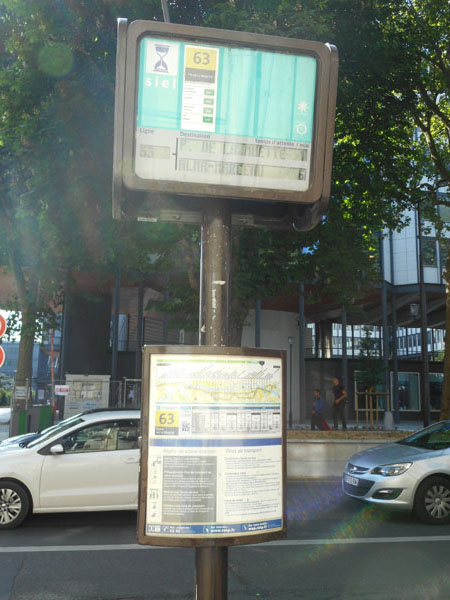 |
| There were other more interesting modes of transport. |
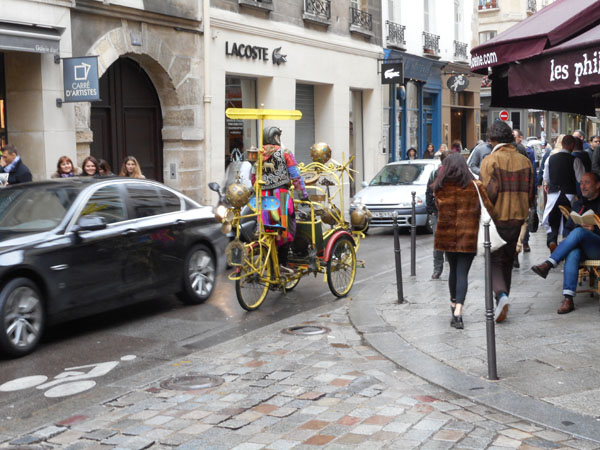 |
| Some specifically aimed at tourists |
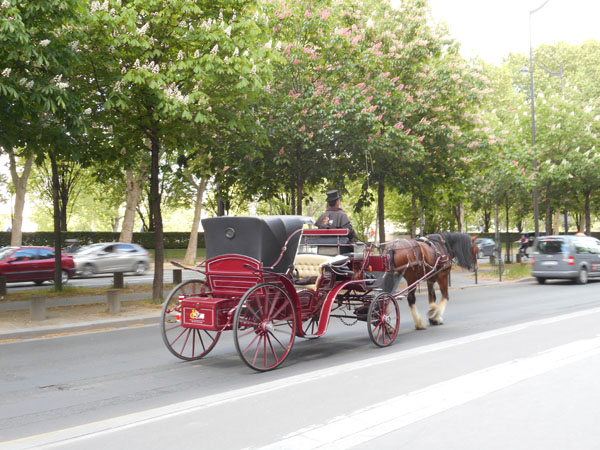 |
| Some very French. Note the 4" heals and the suit protector. |
 |
| There were free bicycles but we mostly saw tourists on them. Motorcycles seemed to be what most locals used: these are for sushi delivery. |
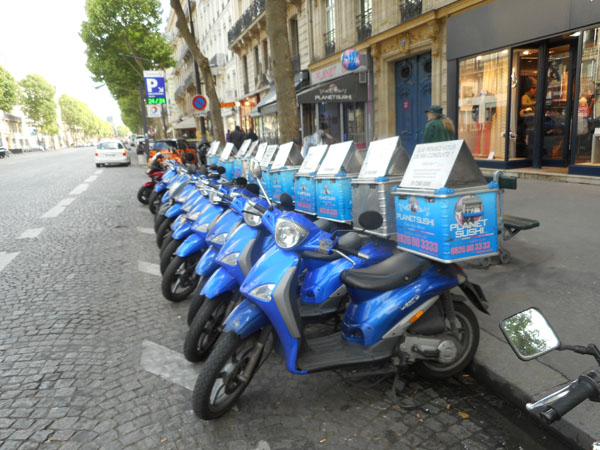 |
| There were also electric cars available for easy short-term rental. |
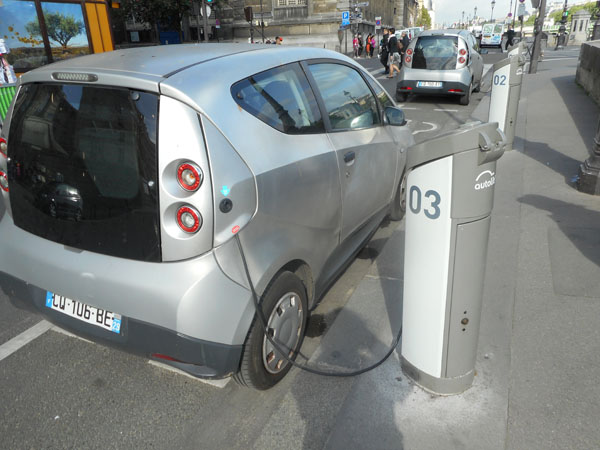 |
Street-level car parking was very hard to find and not everything that looked like a parking space actually was (much to chagrin of these clamped vehicles we're sure).
There is an unobtrusive but extensive network of underground parking garages throughout the city. |
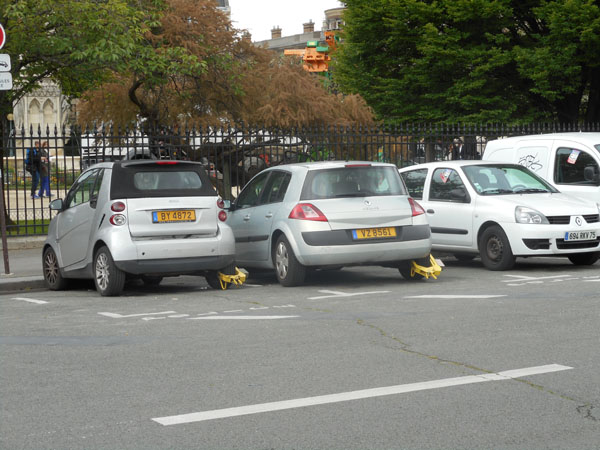 |
| The tight spaces frequently caused us to stop and stare at how they dealt with construction. Here's a construction office: 3 trailers tall suspended up and slightly over the traffic. |
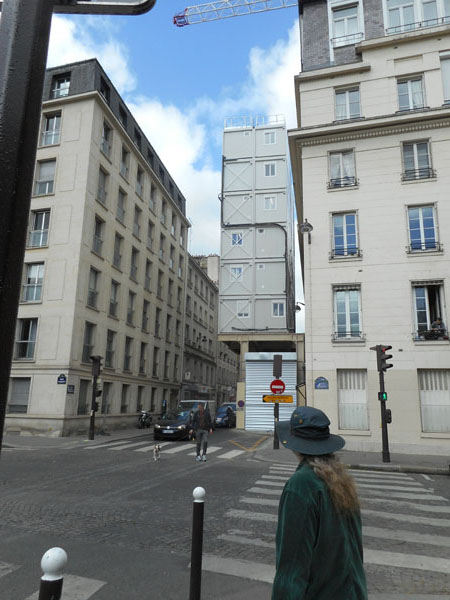 |
| As with everything in Paris, we pause to present a statue or two. There were statues everywhere. This is Charles the great (AKA Charlemagne) in front of Notre Dame |
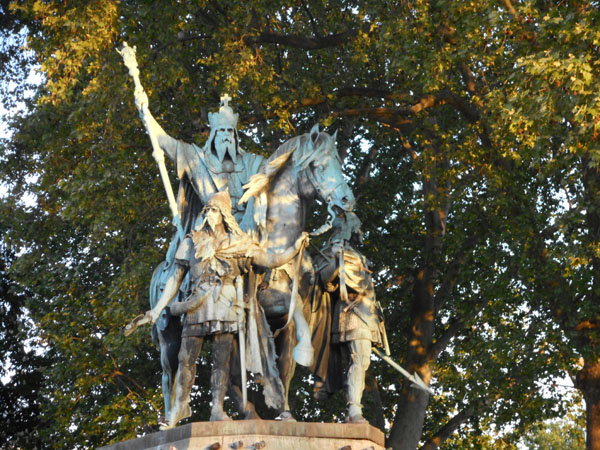 |
| Joan of Arc popped up in a number of places |
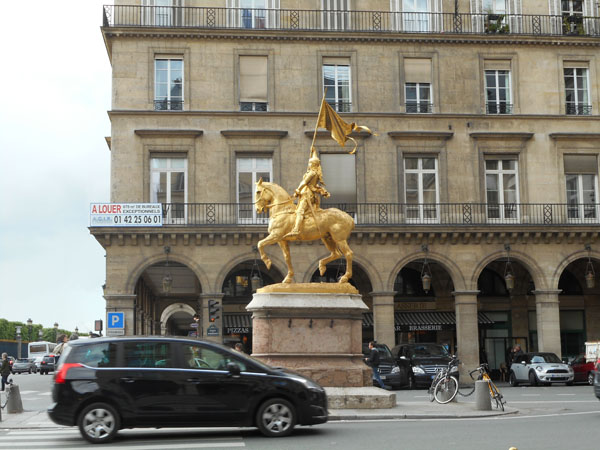 |
| Sometimes life was just a big party... |
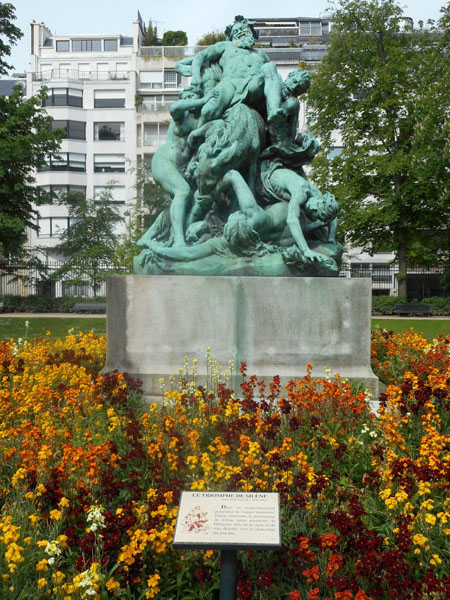 |
| ... or historic |
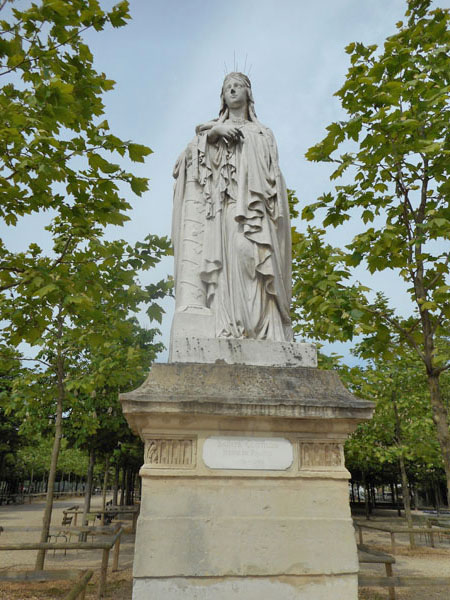 |
| nature |
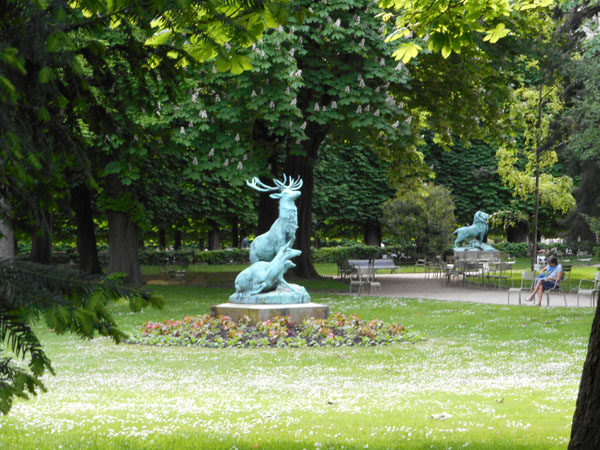 |
And I wish I knew....
Hey! There was a plaque! (er, in French, and the subtleties of the nuances didn't make it entirely clear how the Fox fit in)
It's the poet Jean De La Fontaine, who wrote many books of "Aesop's fables". One of which was The Crow and The Fox. |
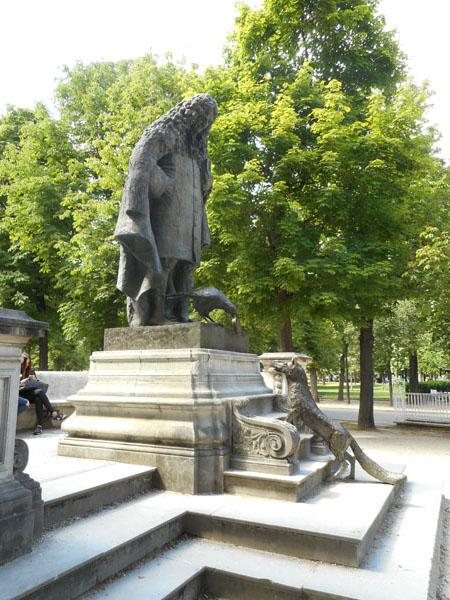 |
| We saw at least 5 statues of Liberty |
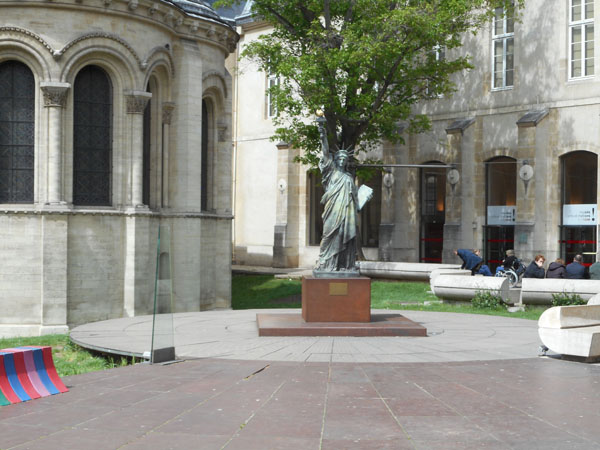 |
| And most had Americans posing for photos. These folks were from "all over" including Philadelphia and Georgia if Karen remembers correctly. |
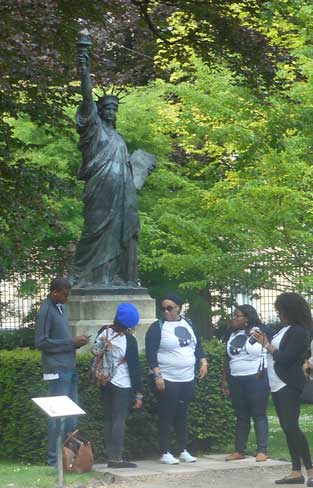 |
| This isn't just a statue, it's a fountain. Hundreds were erected around town by a British philantropist to benefit the poor. |
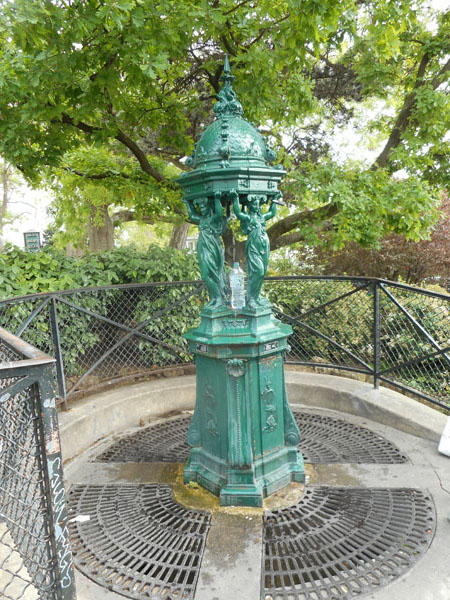 |
| We had to remember to look up as well: These gargoyles were on Notre Dame but many bulidings had interesting elements above our heads |
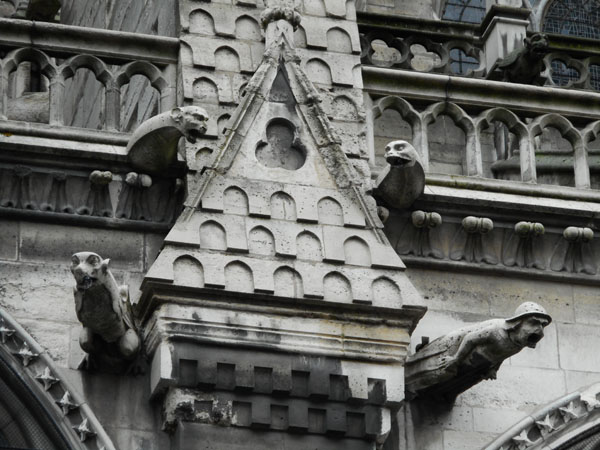 |
| |
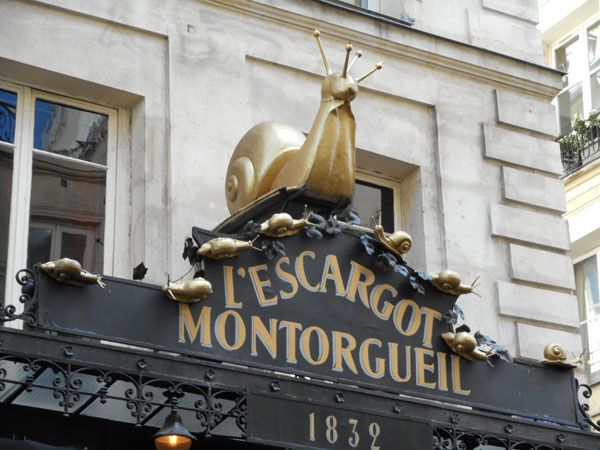 |
| |
 |
| And not all of them were put there by the builders (We hope you can see the the mice). |
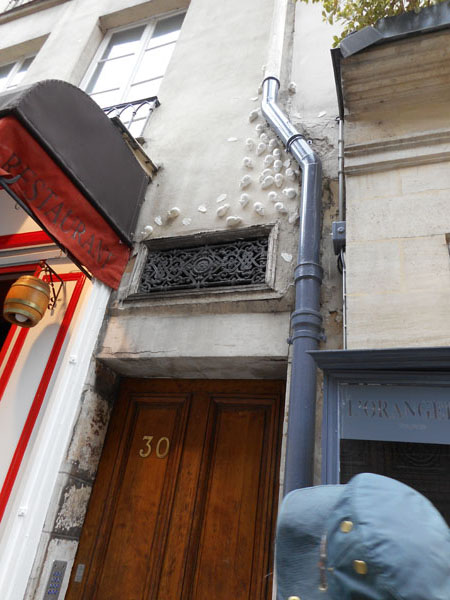 |
| In many spots we ran into historic markers. Some, like this Cyrano de Bergerac marker, we had some knowledge of. |
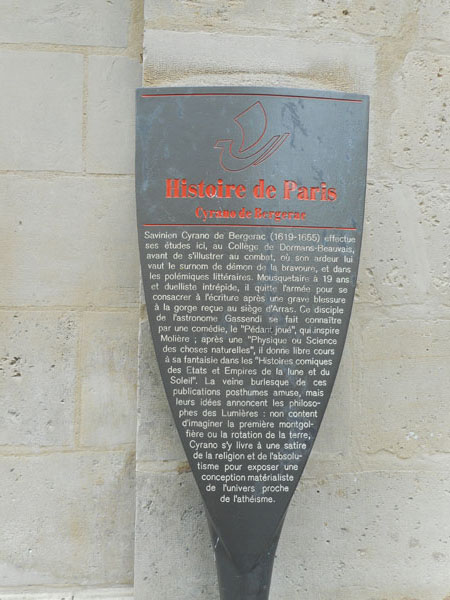 |
| Others, like this chunk of ancient wall, we could figure out with the help of Dick's French. |
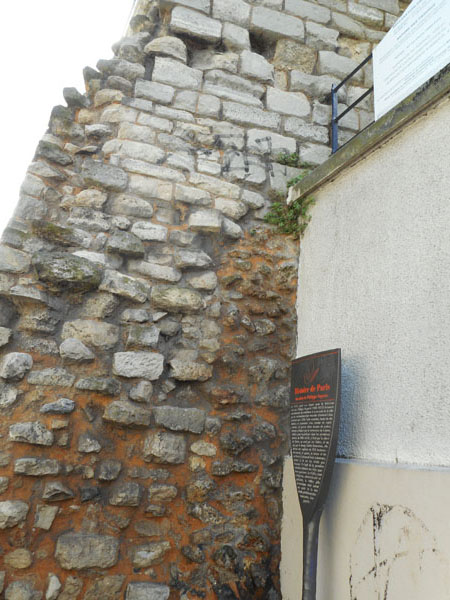 |
We never did quite figure out the chicken art installation or what ever it was. The painted web address didn't work. Research back in Seattle revealed that it's a demonstration
"henhouse in a container".
There are 5 tons of dirt and grass where the chickens are walking. |
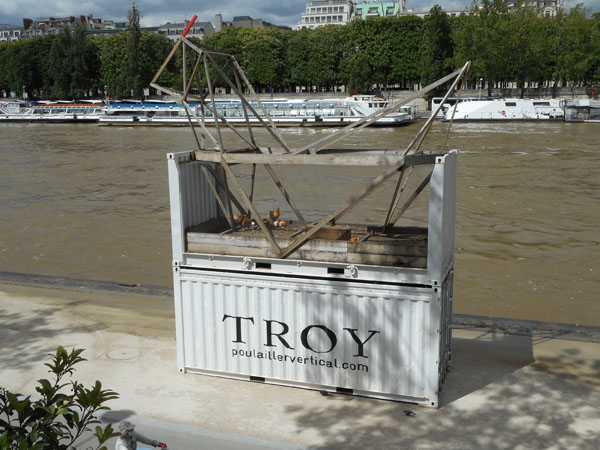 |
| The same playfulness was found in most of the parks. There was almost always an area devoted to children. |
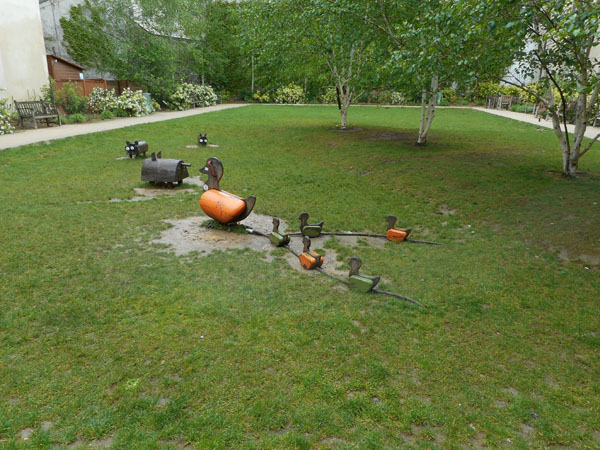 |
| We also spent a lot of time looking in windows. Lots of antiques. |
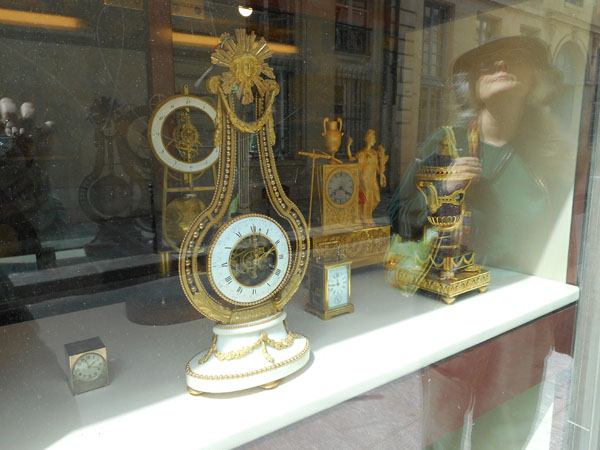 |
| As well as interesting newer things: take a close look at the clock faces. |
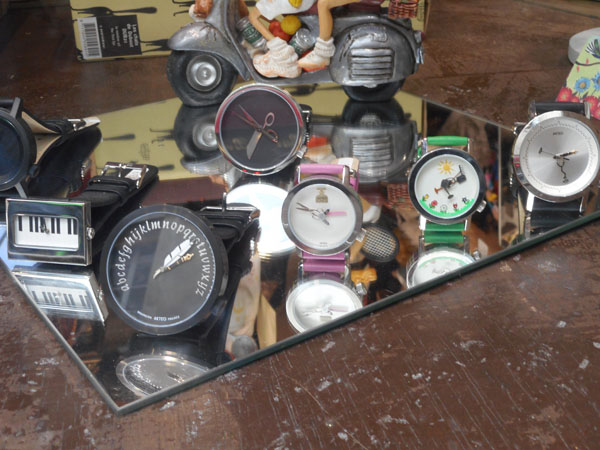 |
| old and new instruments |
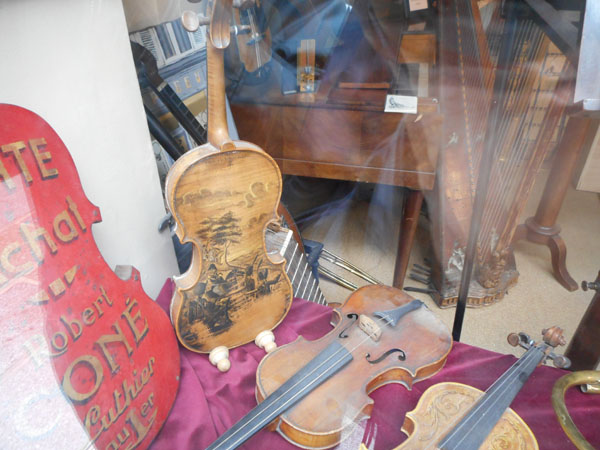 |
| new sculptures |
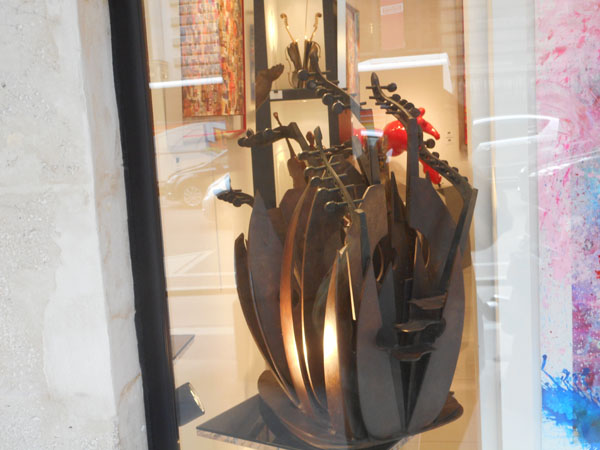 |
| Sedate paintings and some more risque: This was both. As we walked by the painted woman became dressed as a nun. |
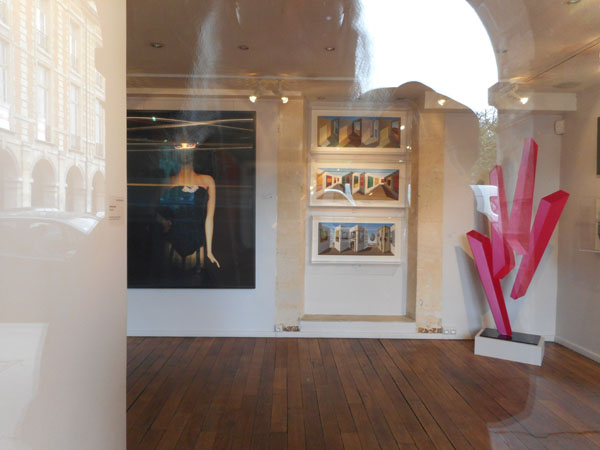 |
| And we found glass. This mosaic and several others were glued to the windows of a restaurant. |
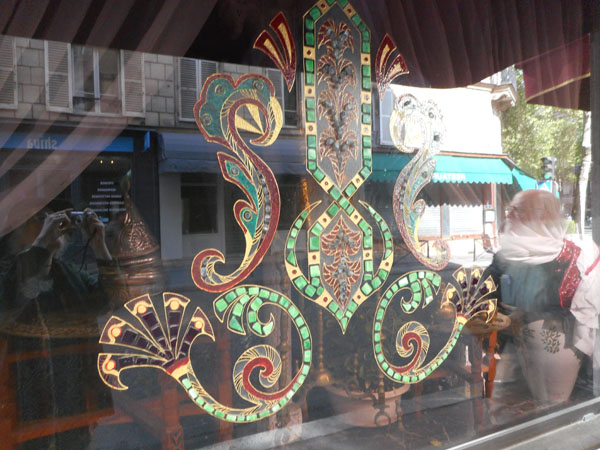 |
| These gallery pieces were probably actually resin, but it inspires glass |
 |
| This was Karen's favorite glass shop of the trip. |
 |
| These giant egg lamps were fun too. |
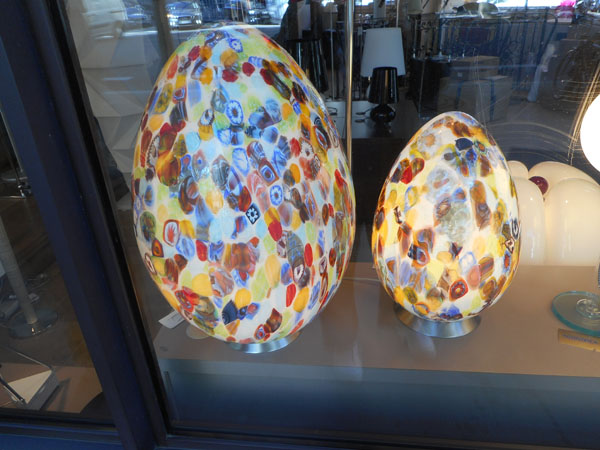 |
| These cushions also caught our fancy as both interesting and fuctional |
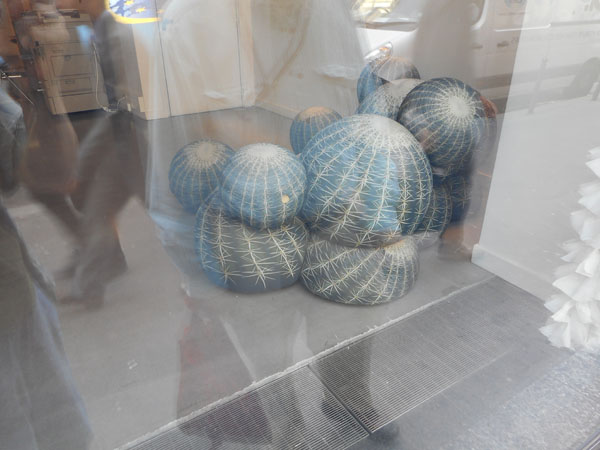 |
| We've heard of flying foxes (a kind of fruit bat) but never a flying wolf. |
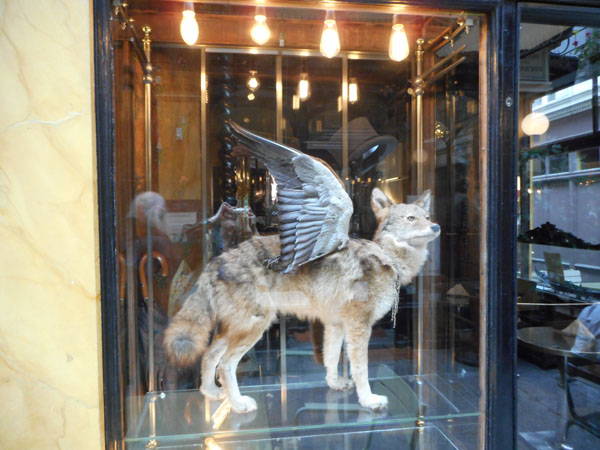 |
| Come wander further with us: wherever the Eiffel tower peeks out, you'll find tourists taking its photo. |
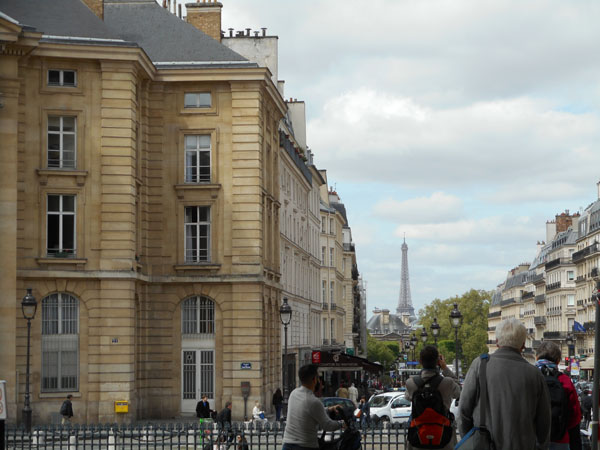 |






























































































































































